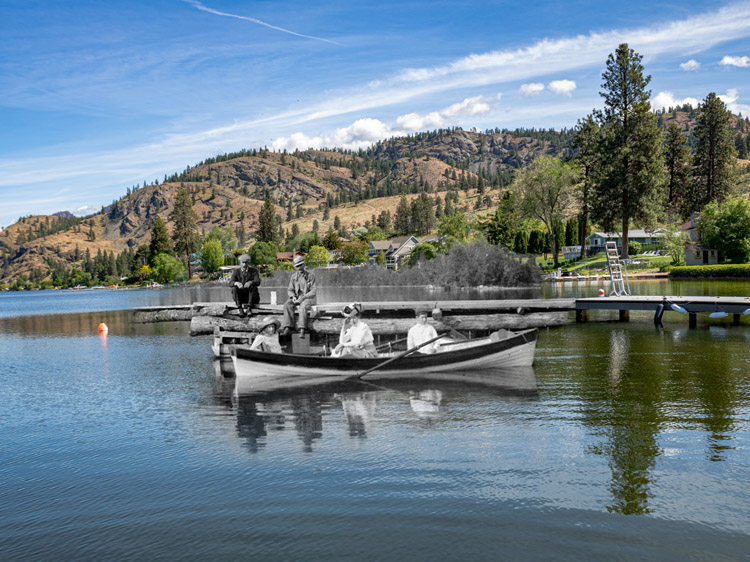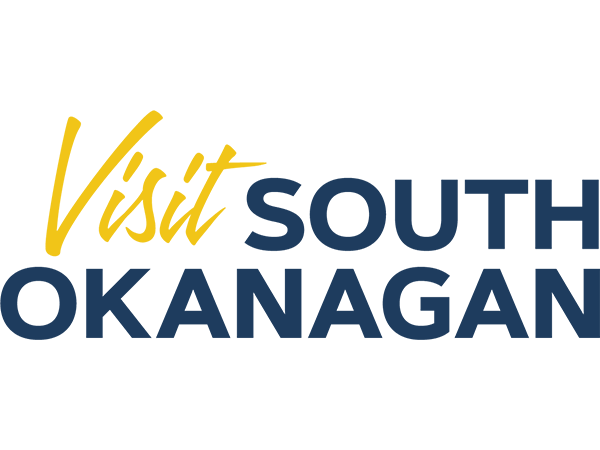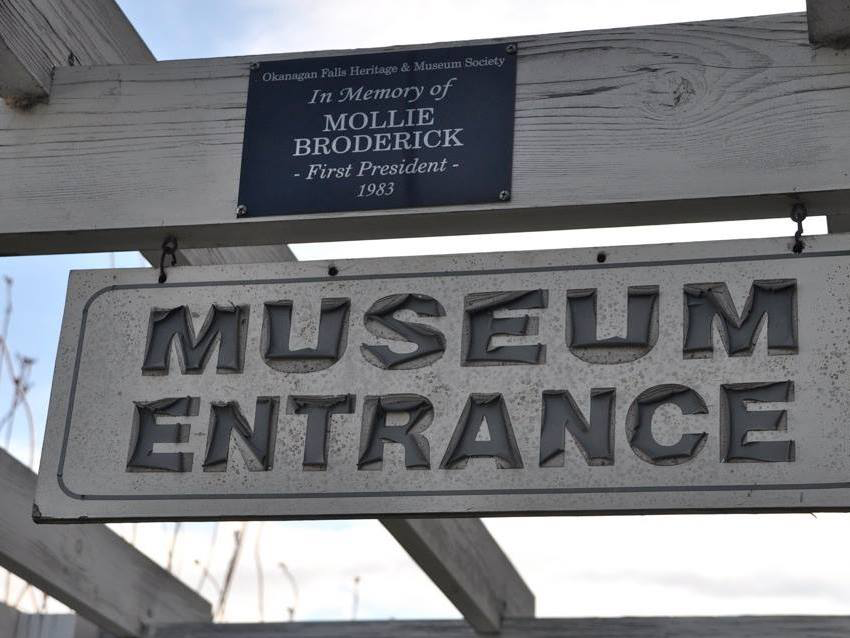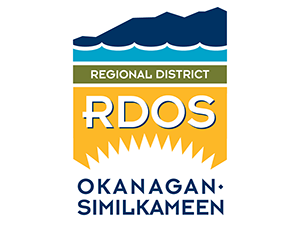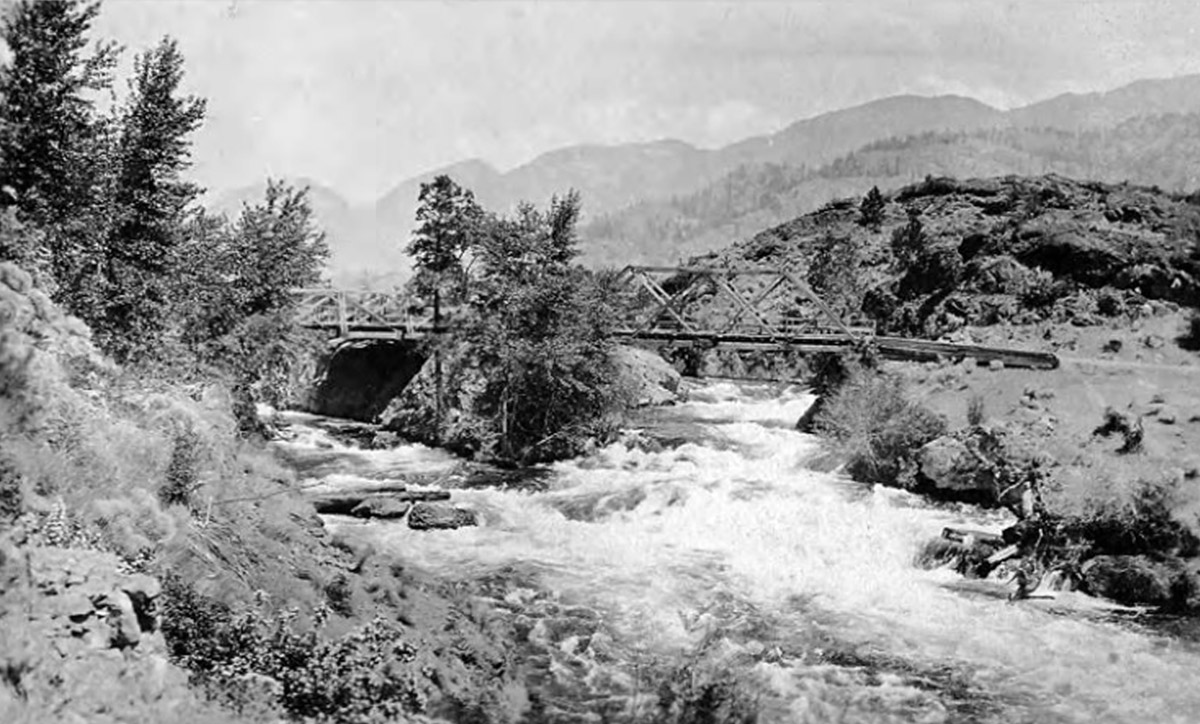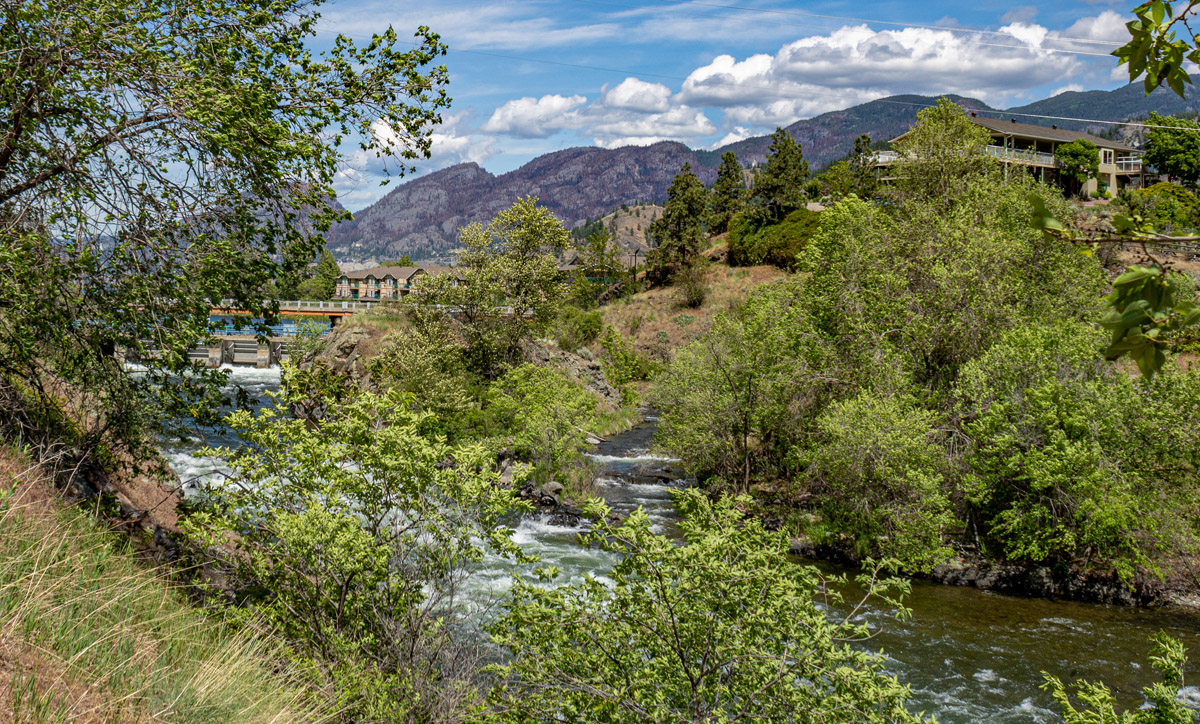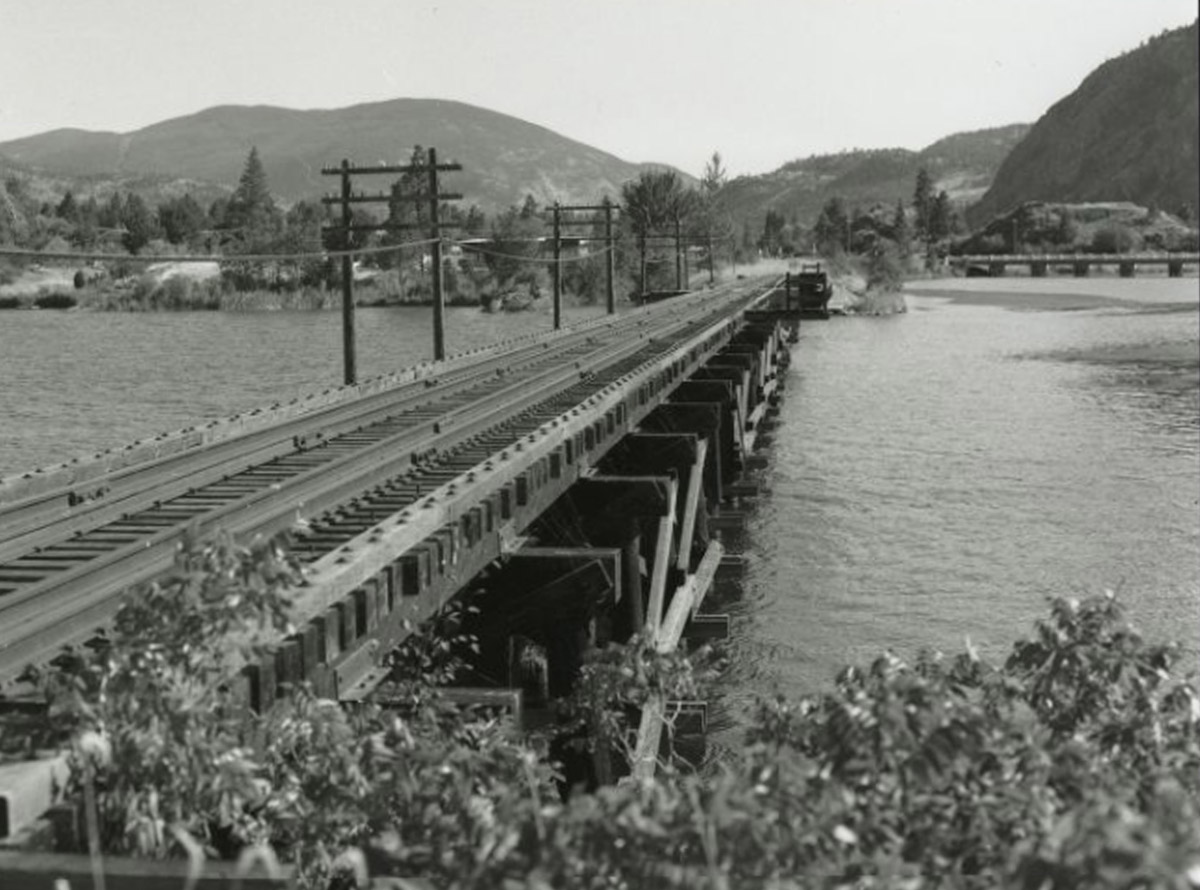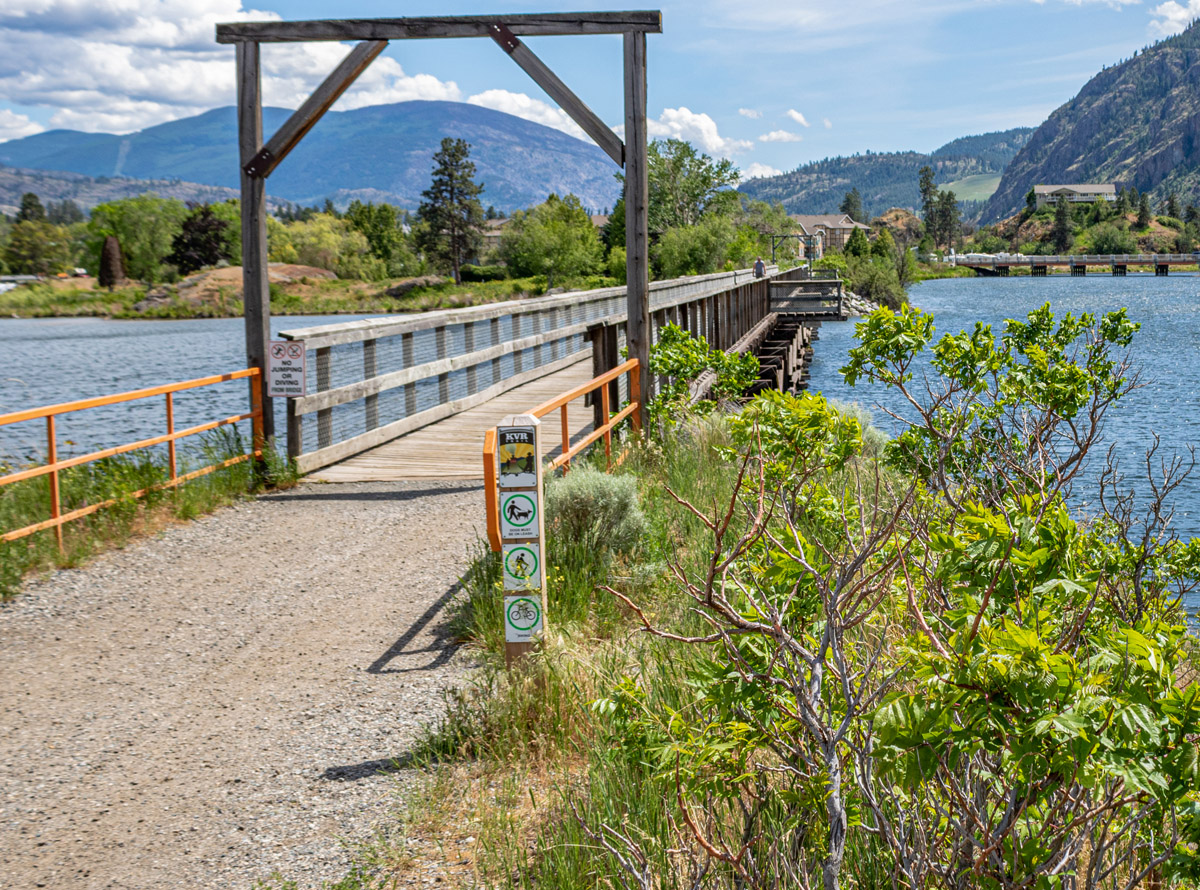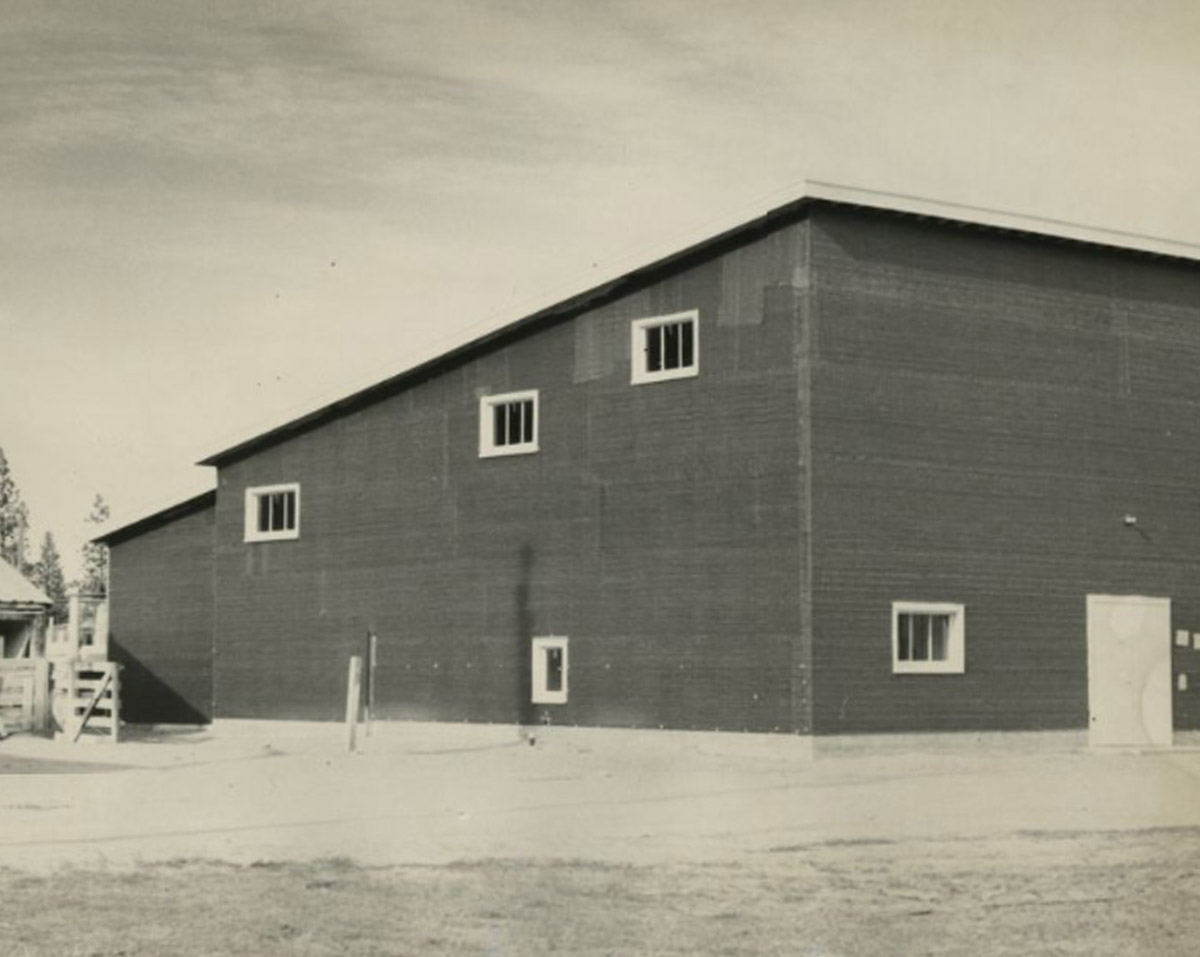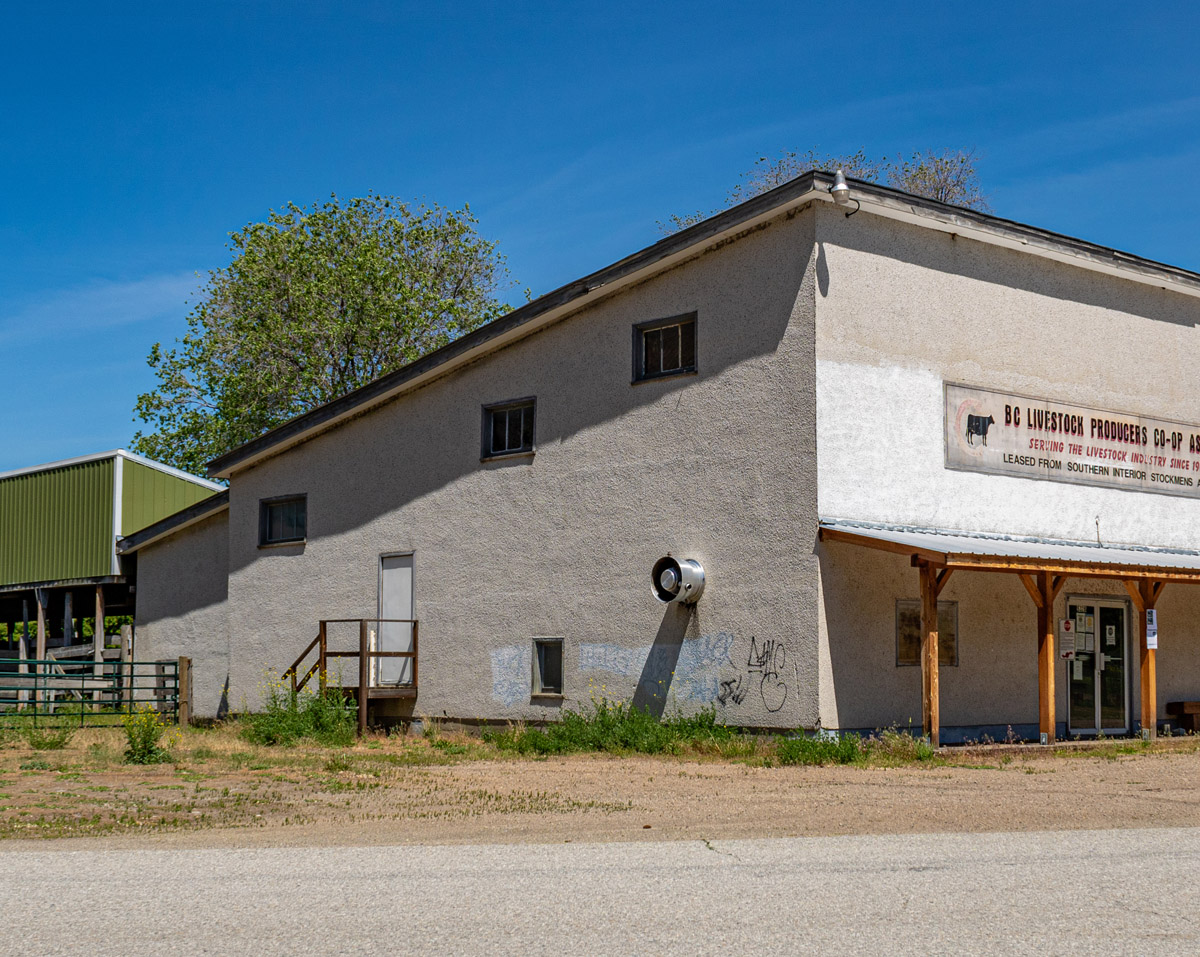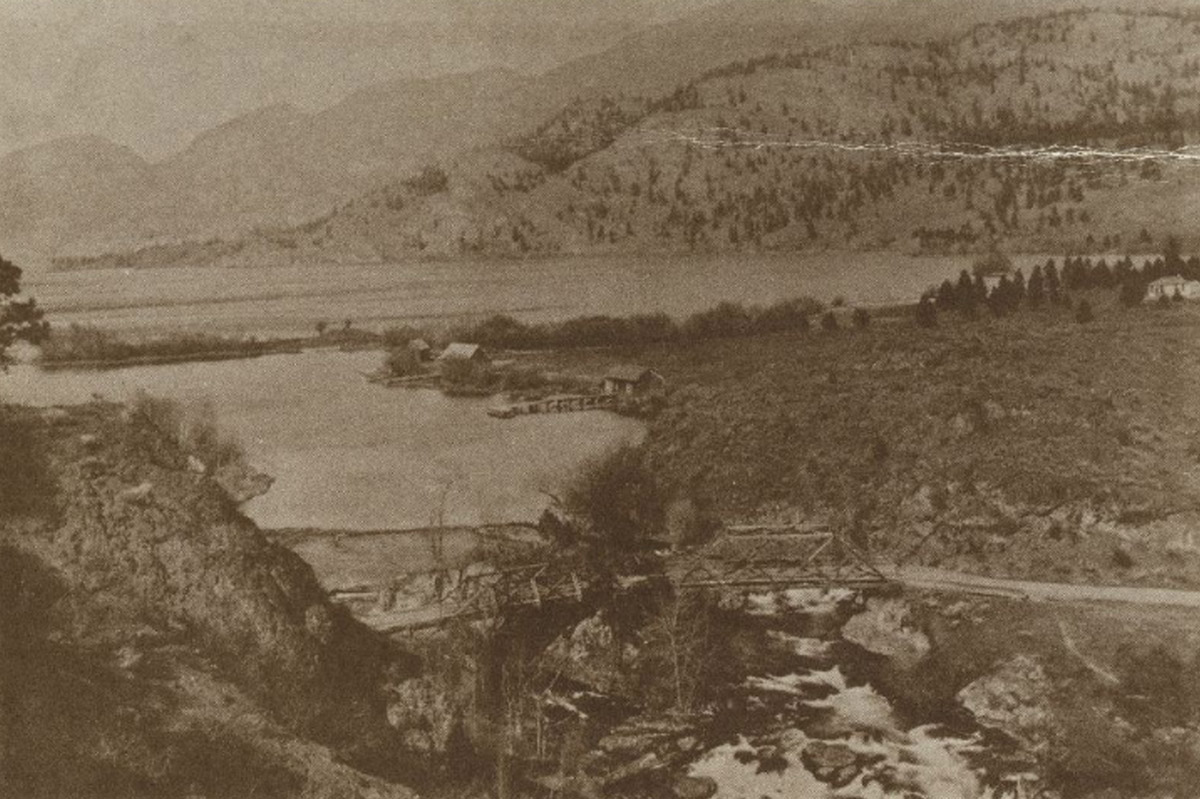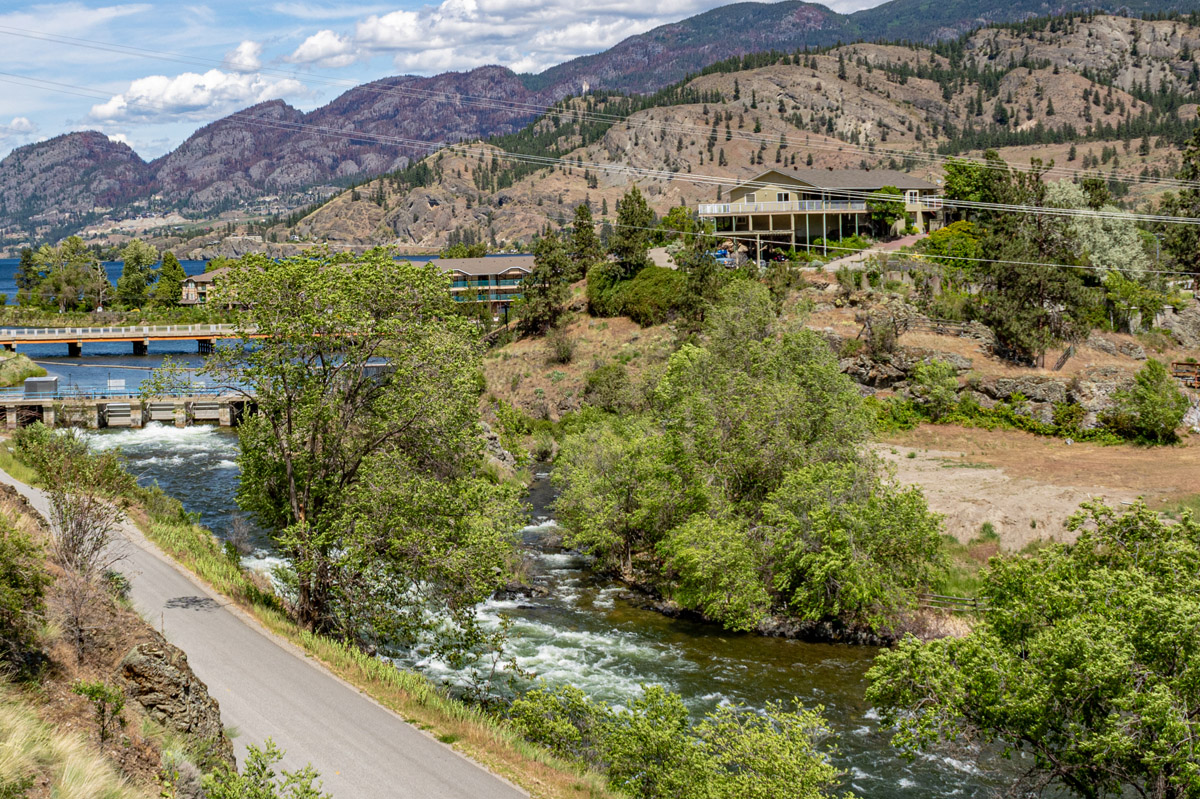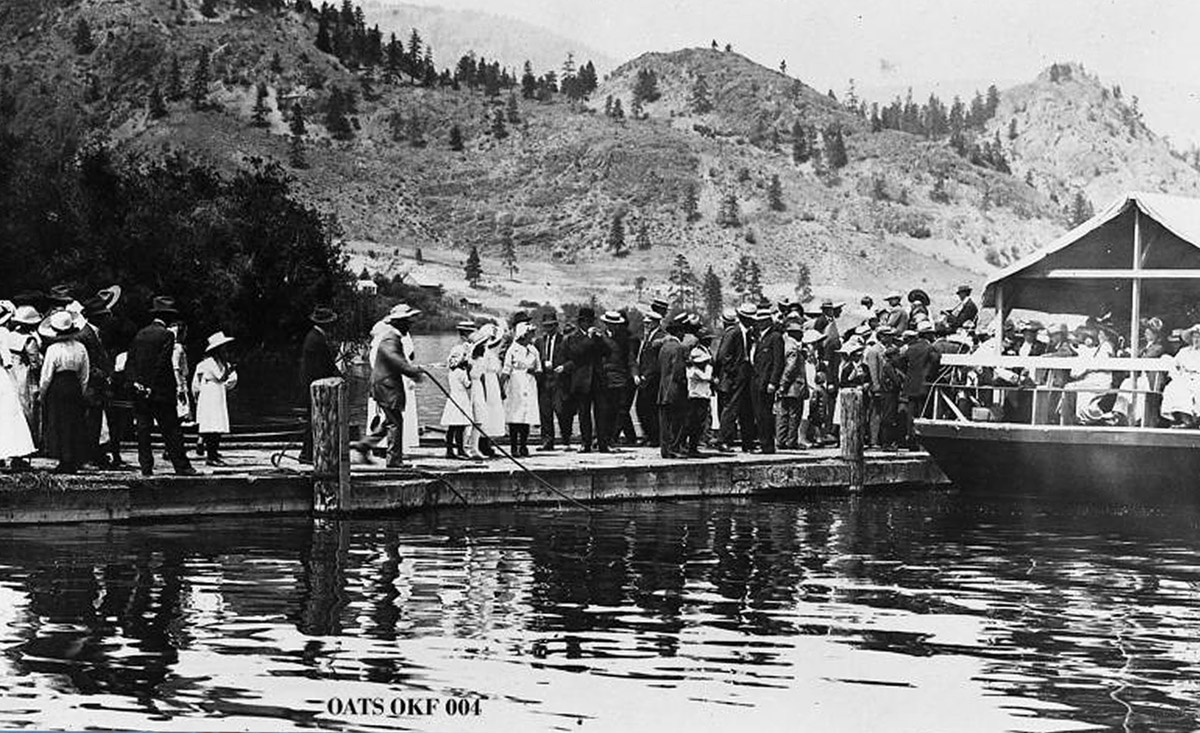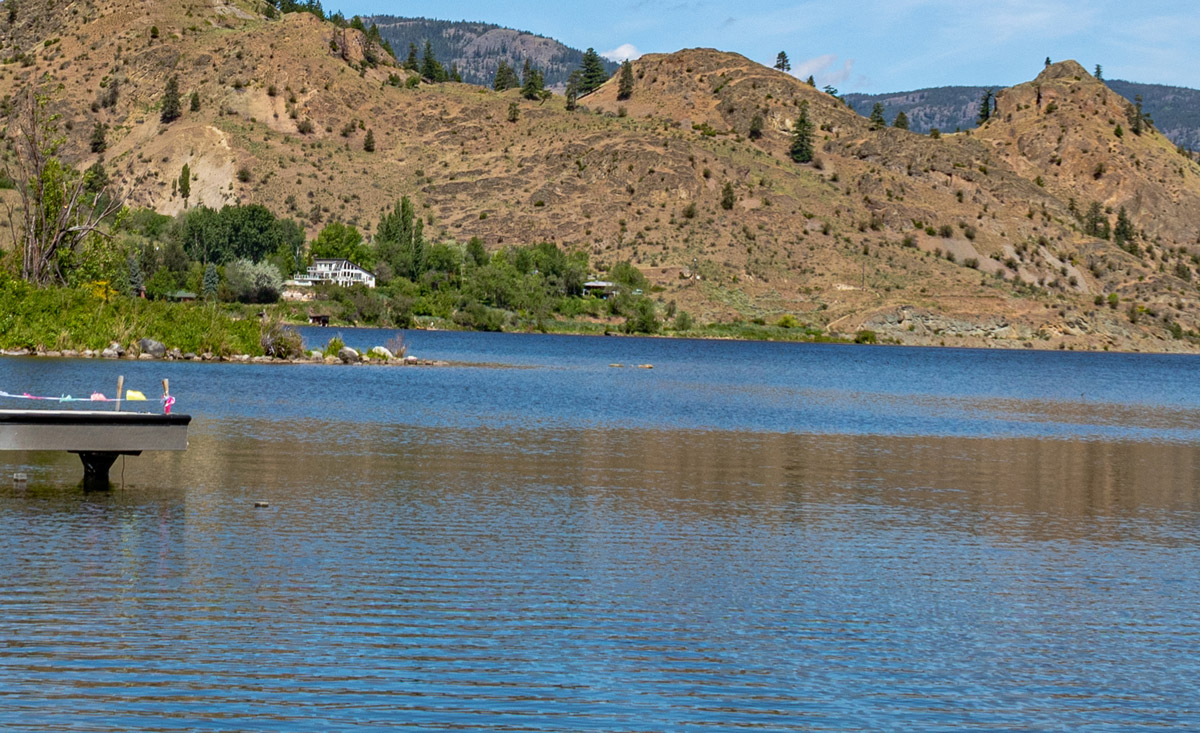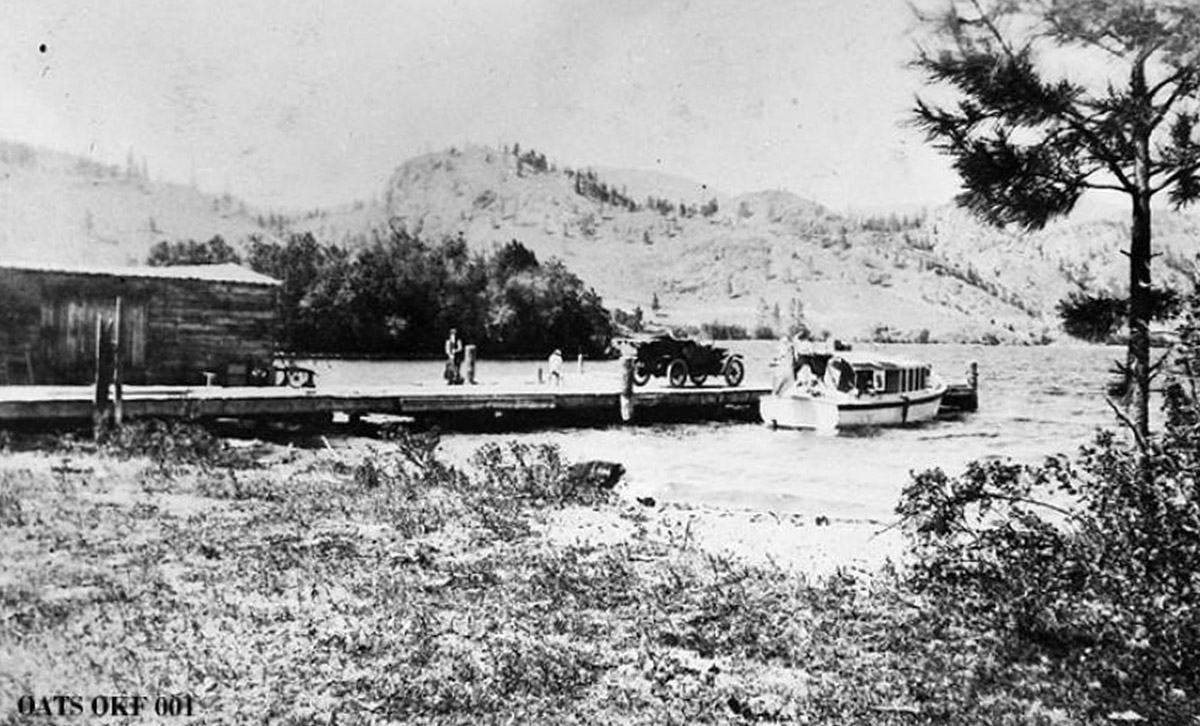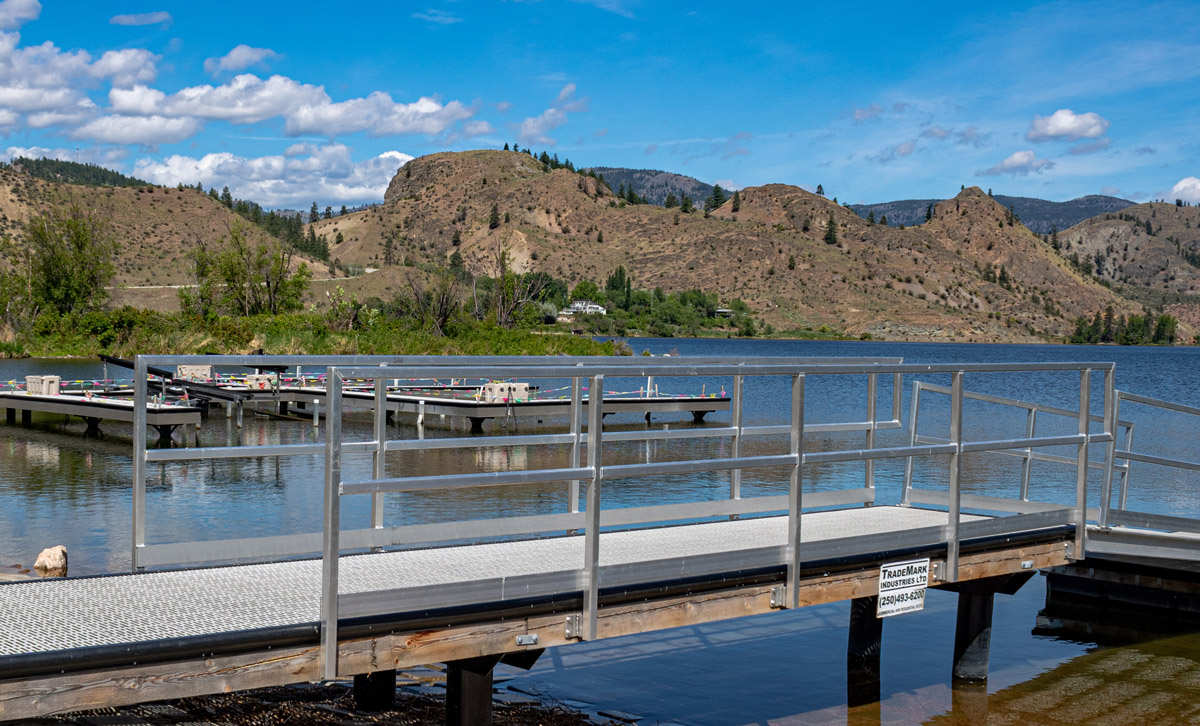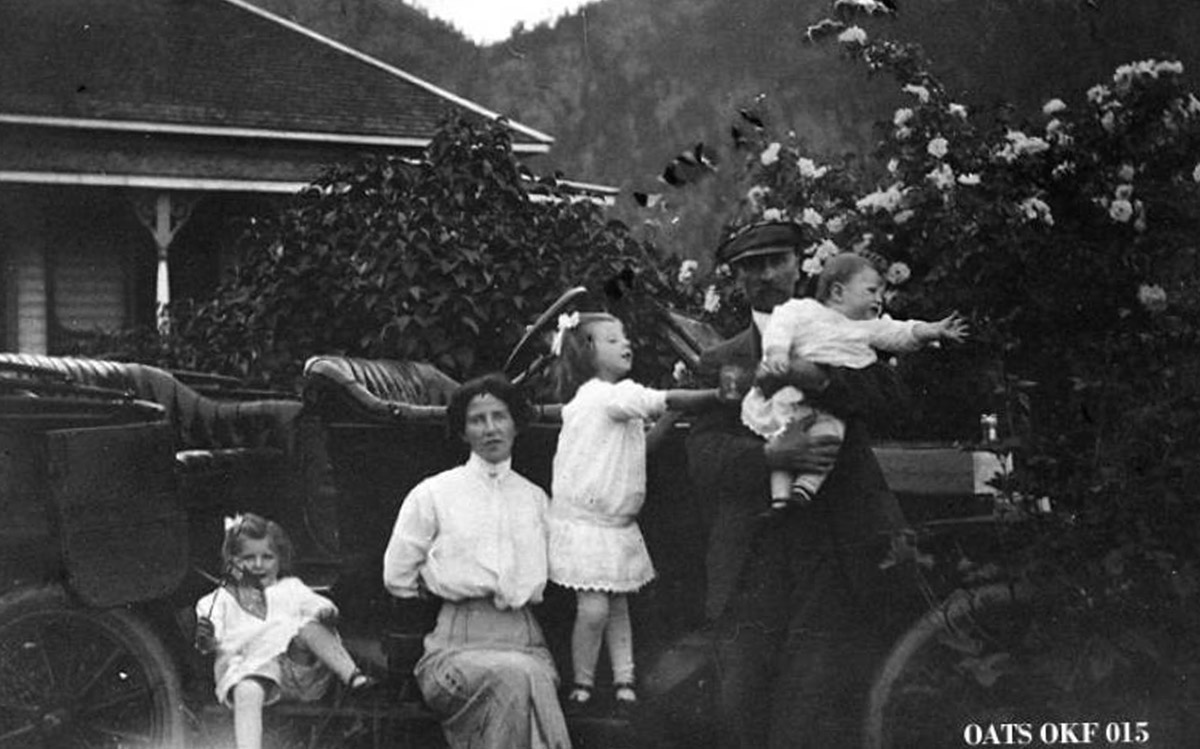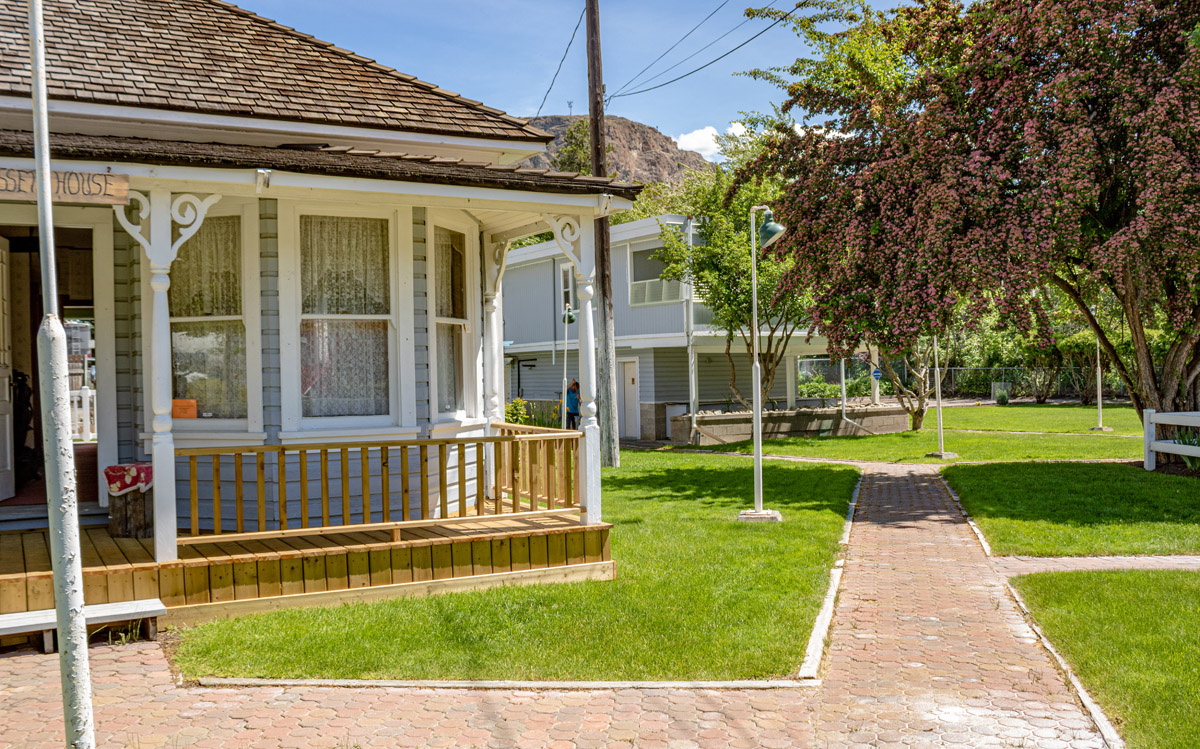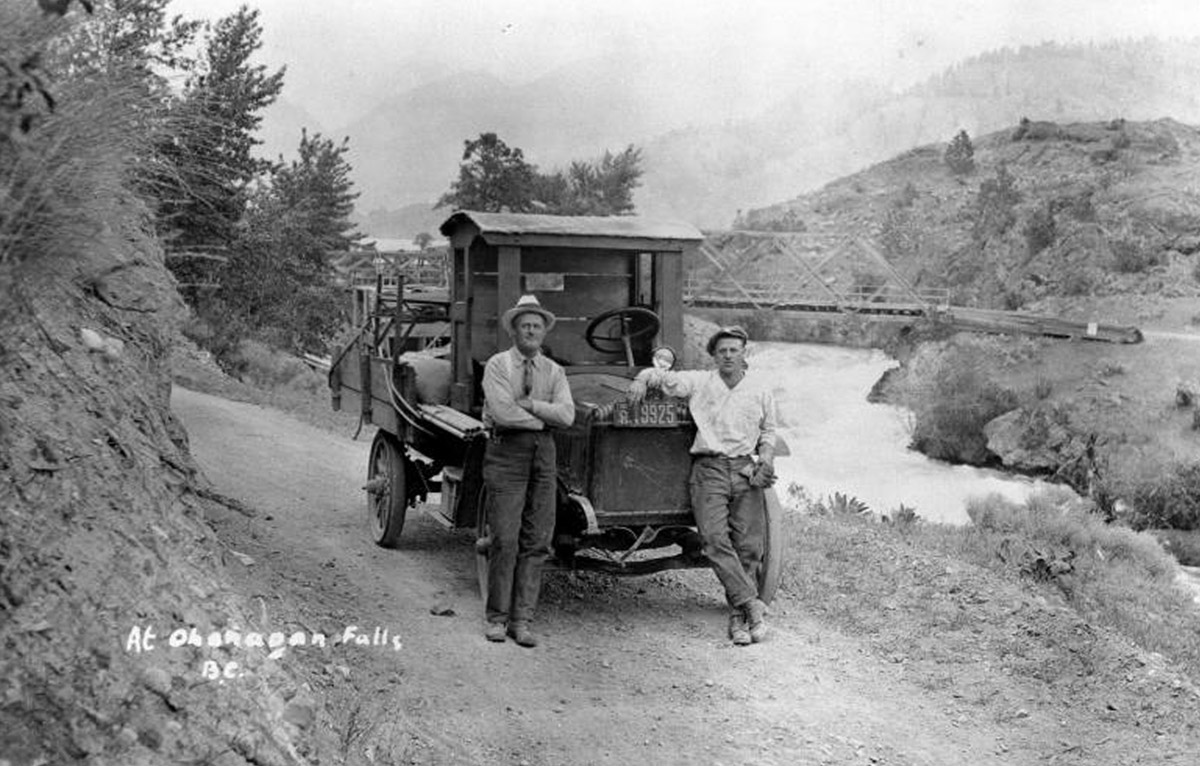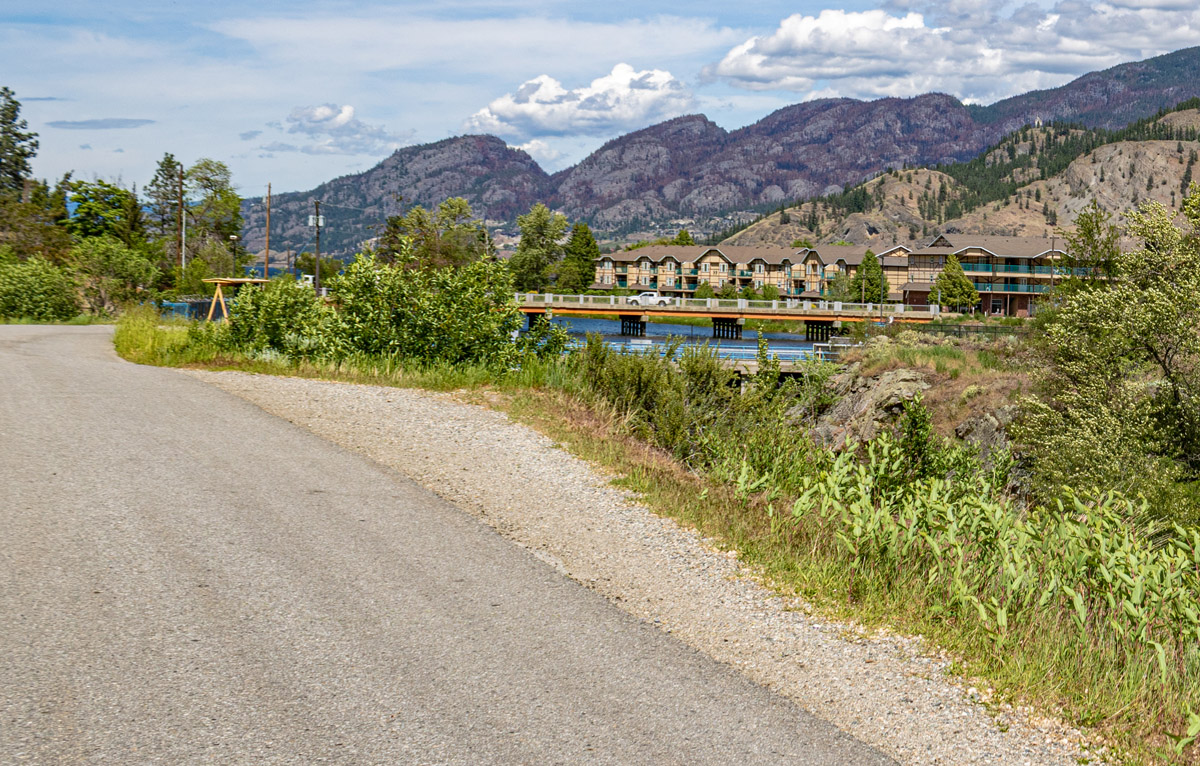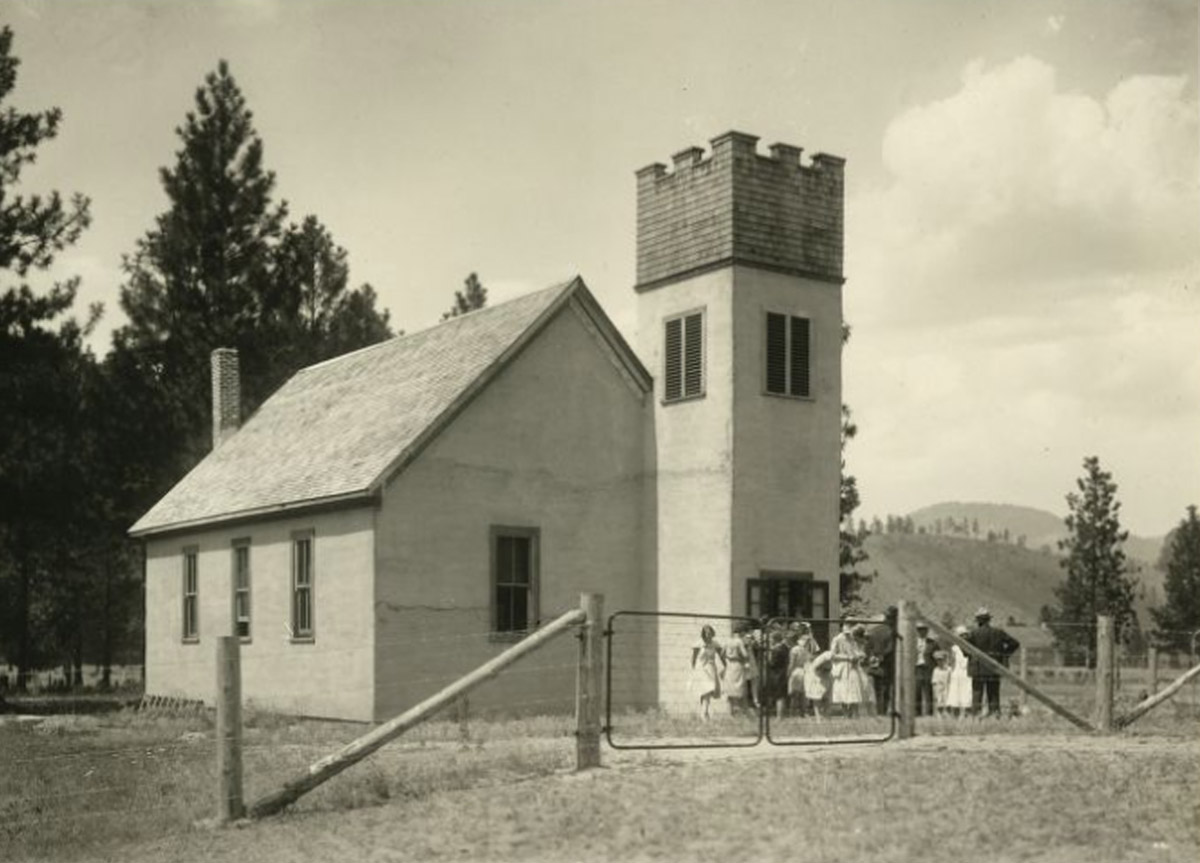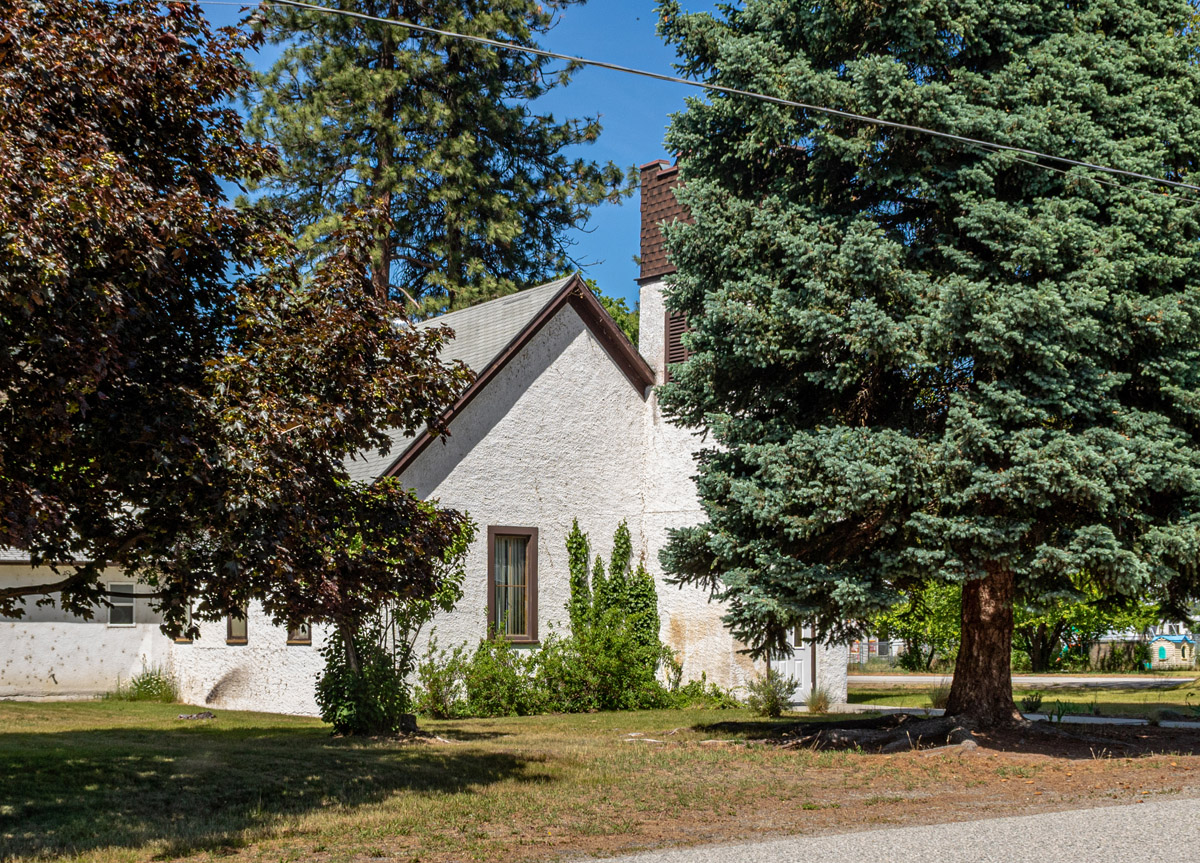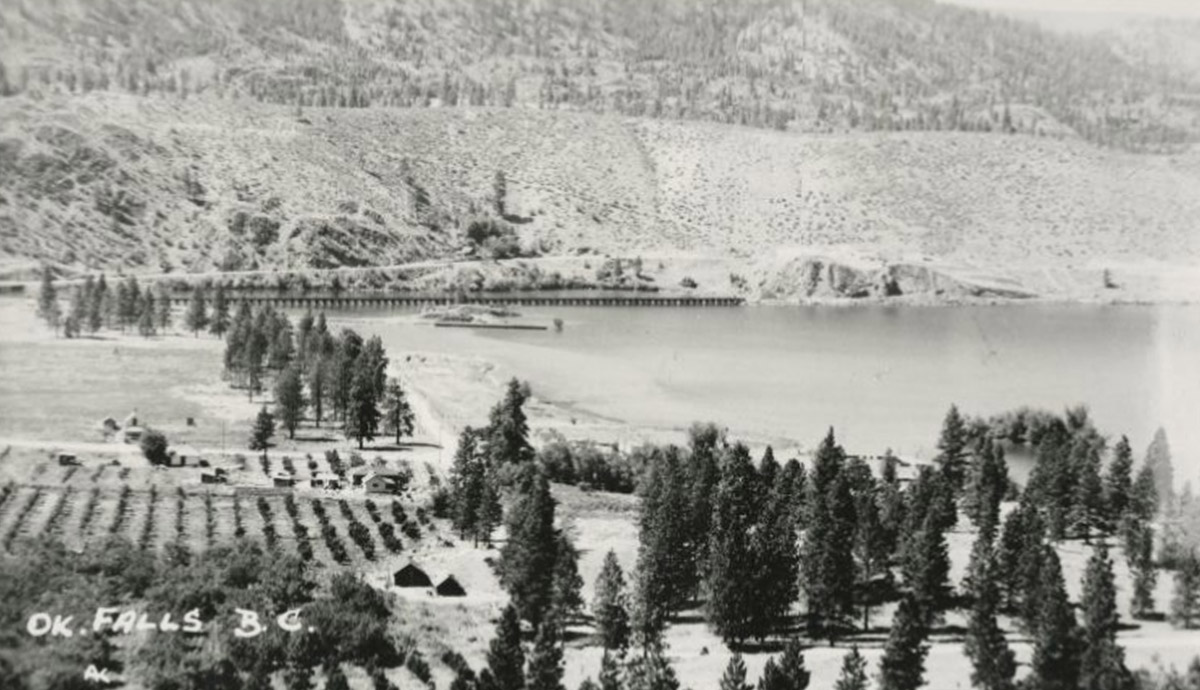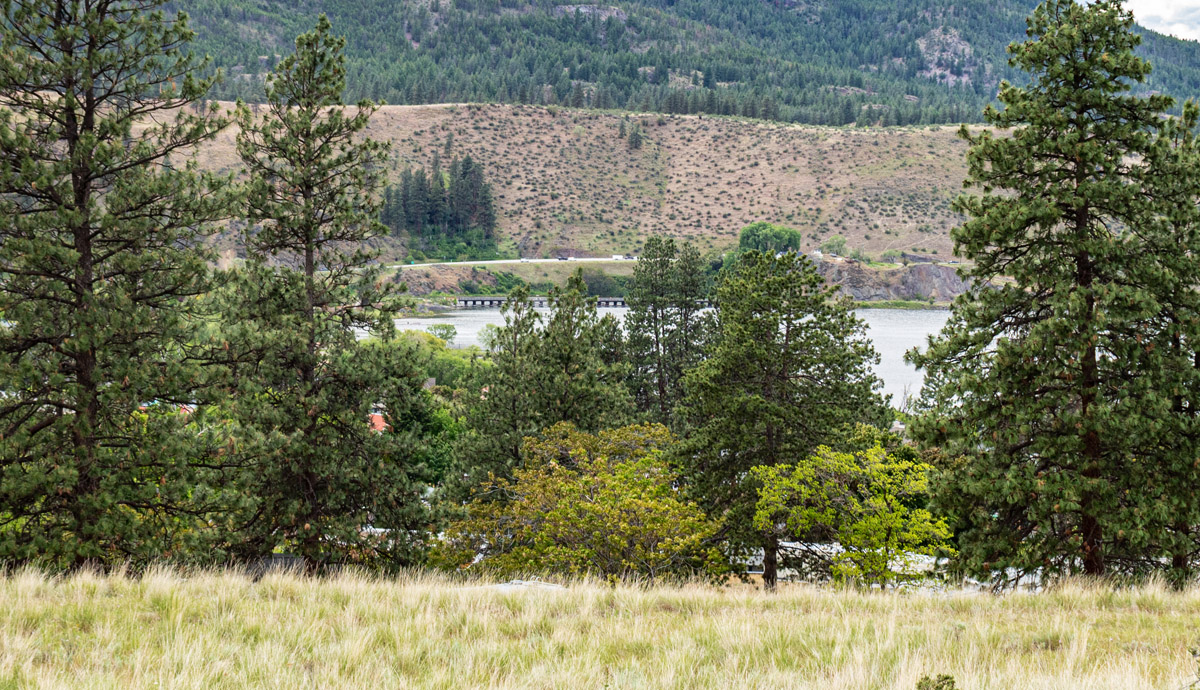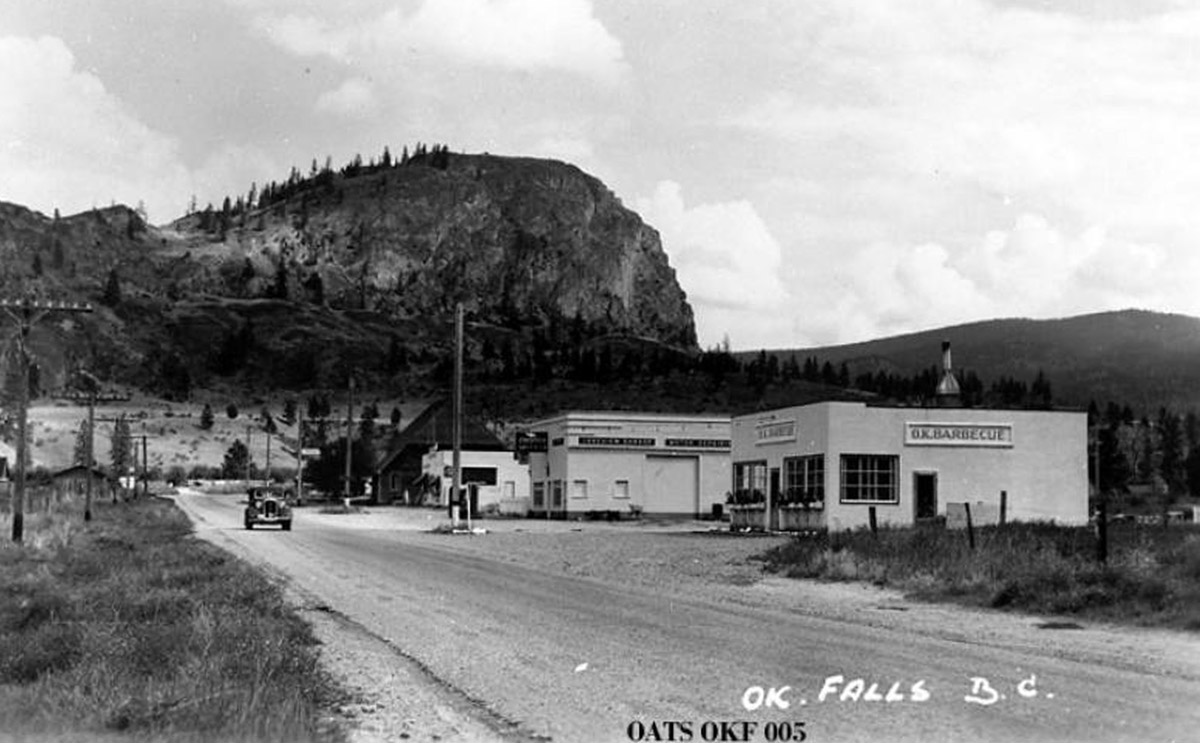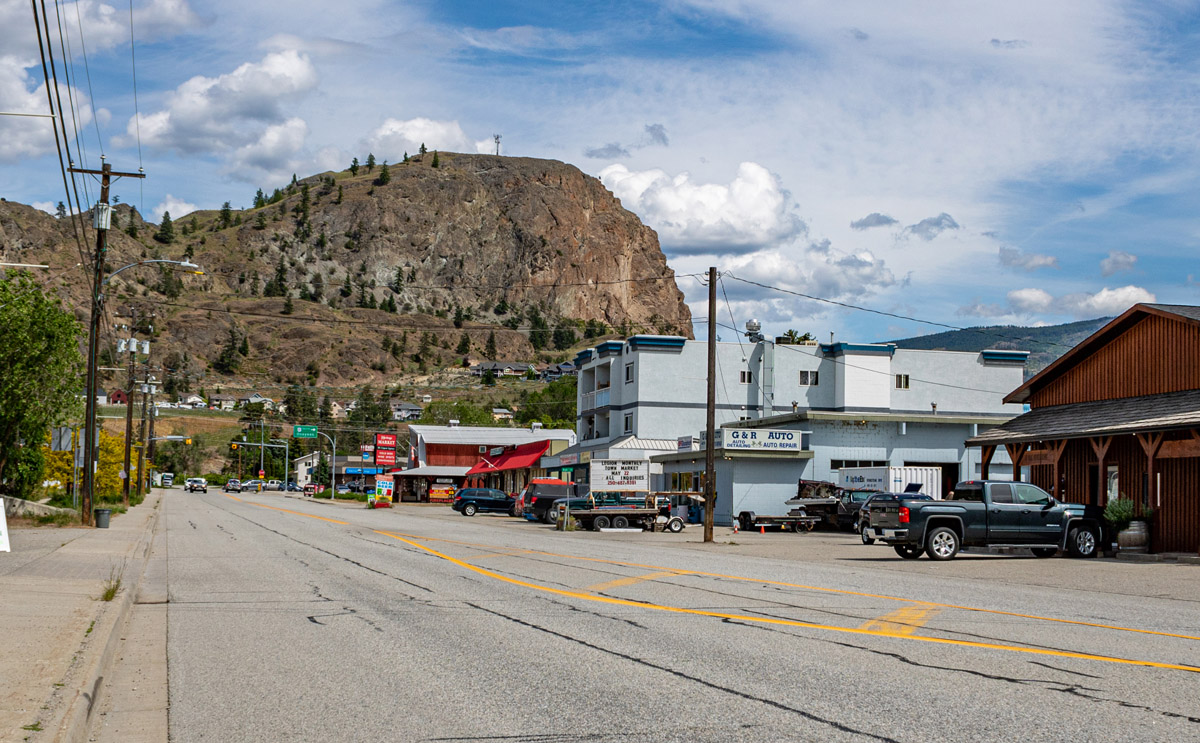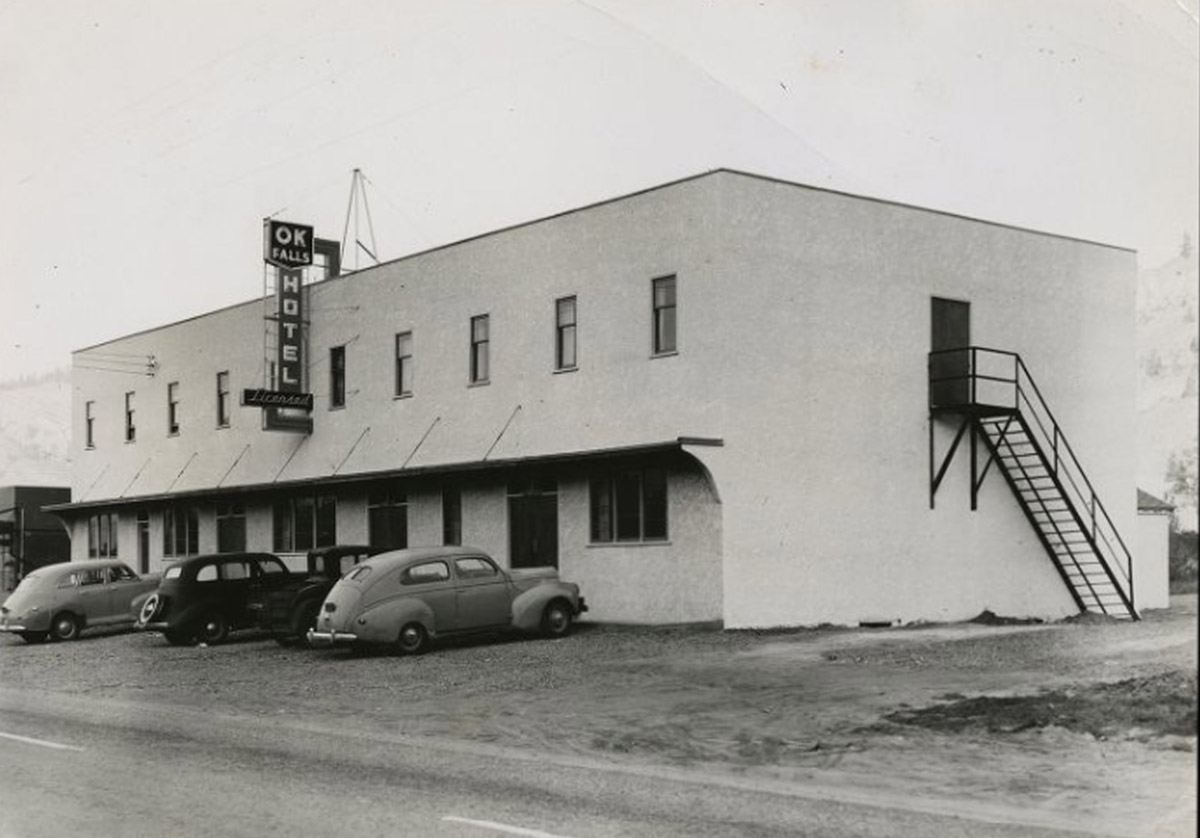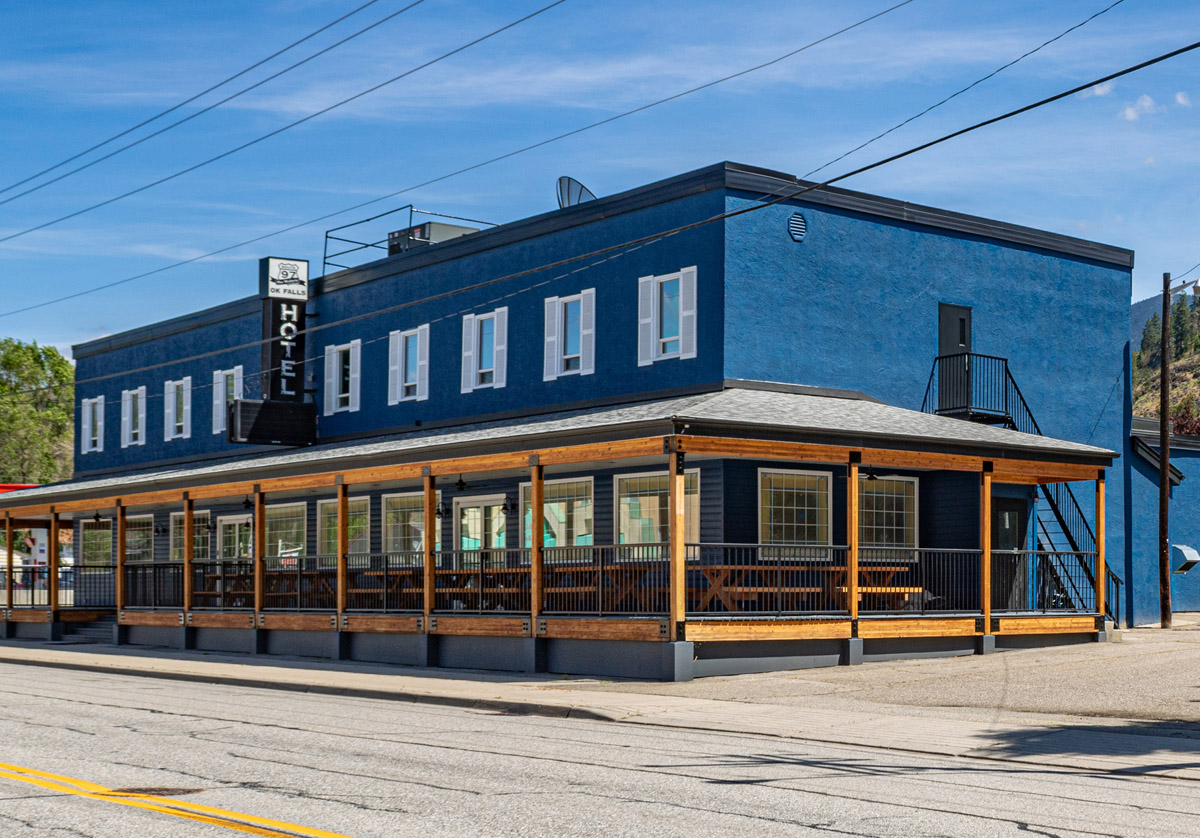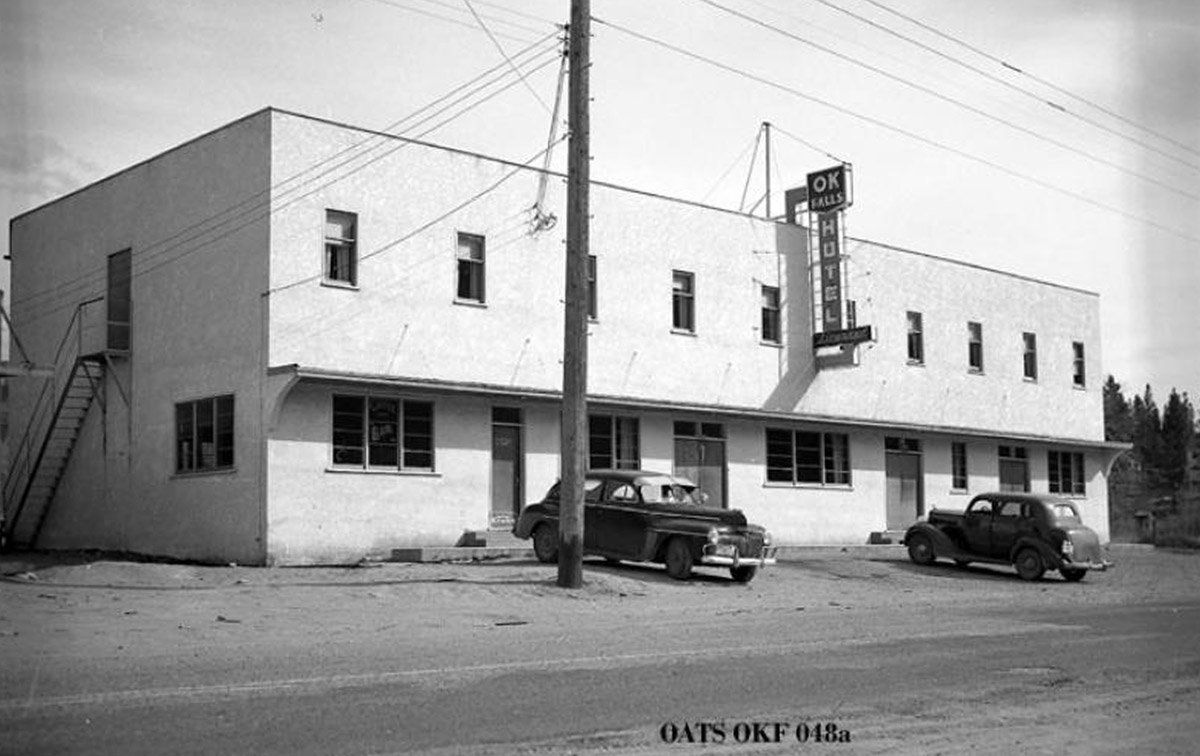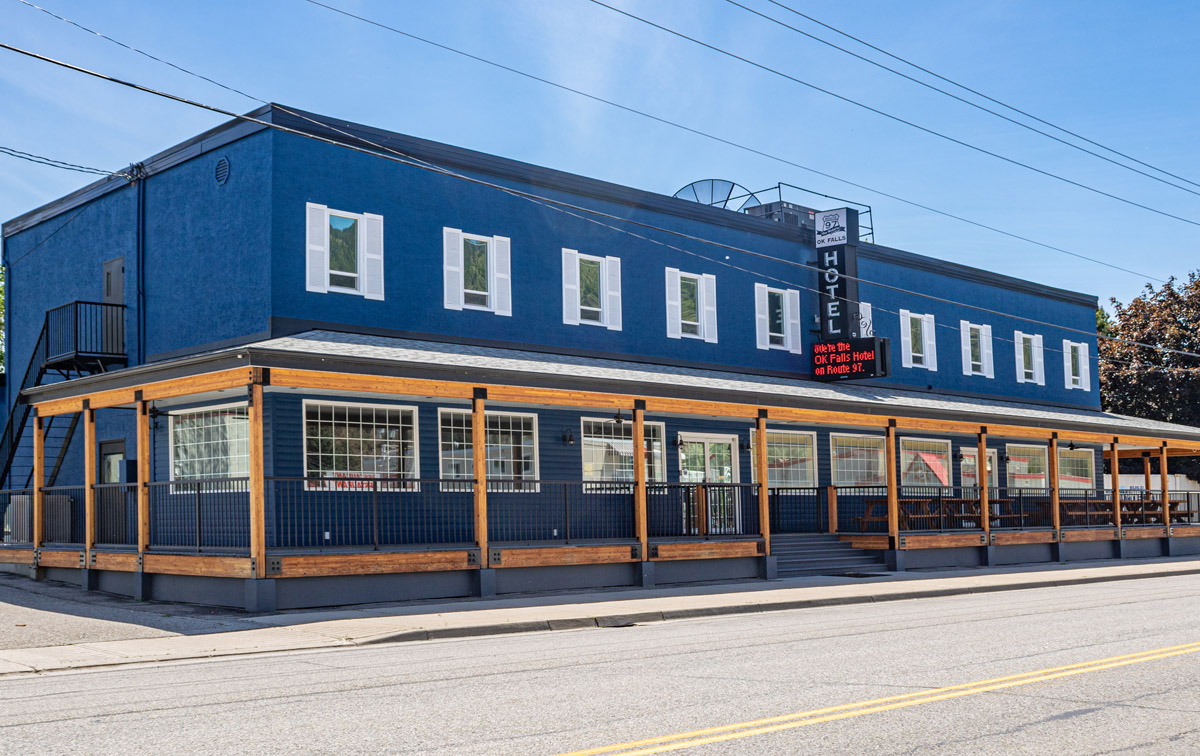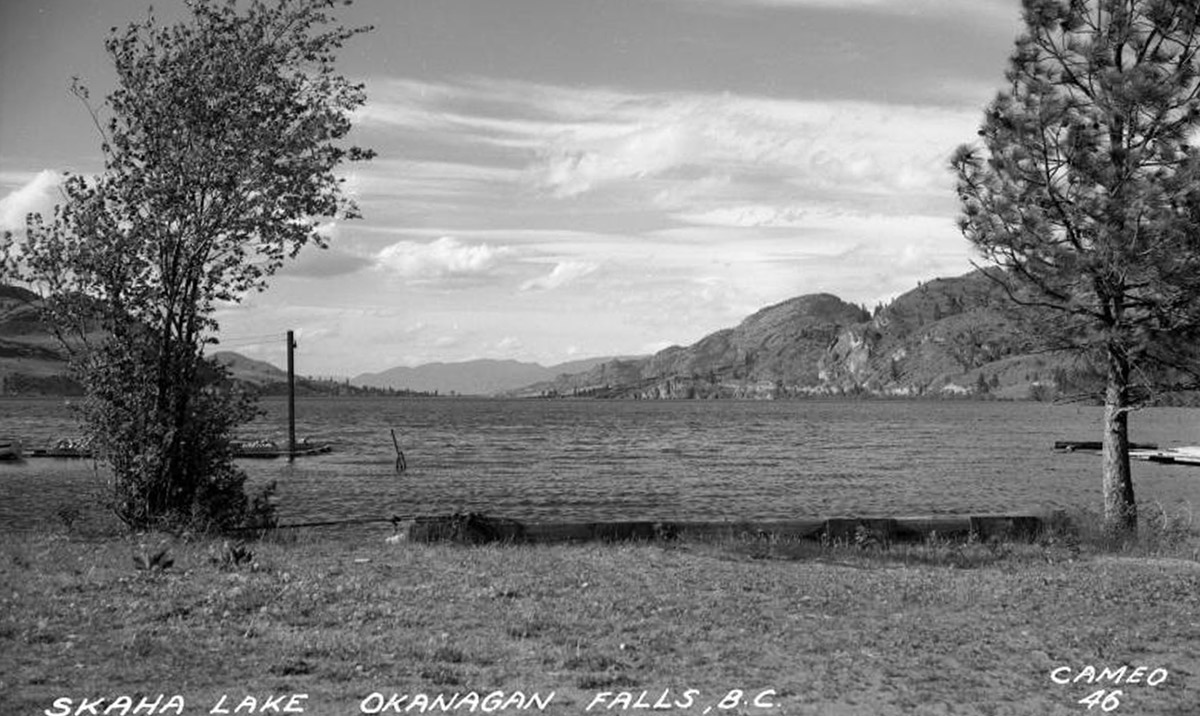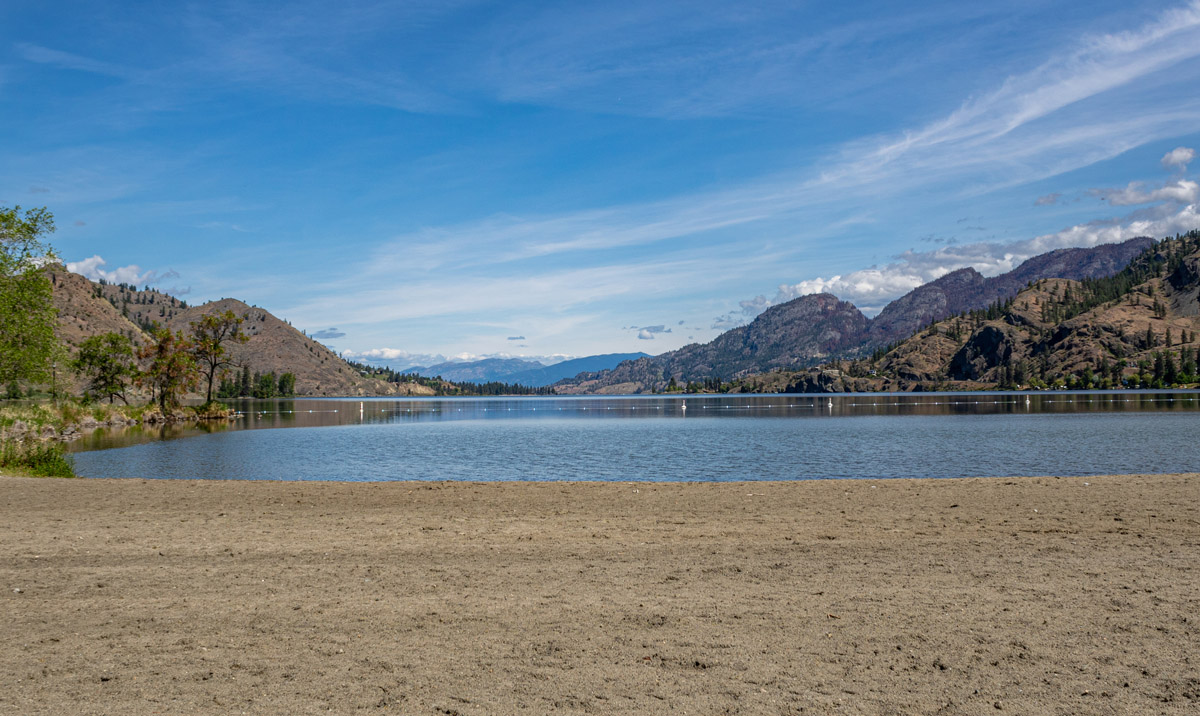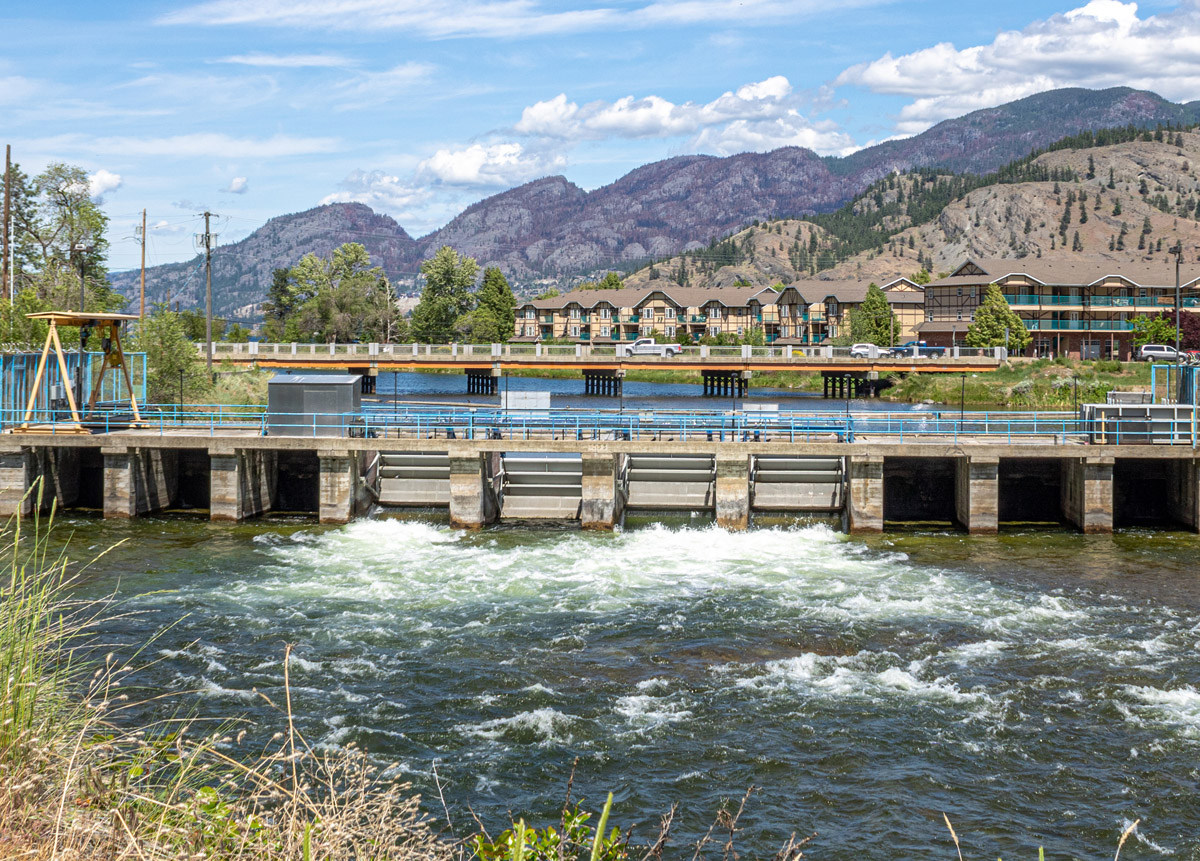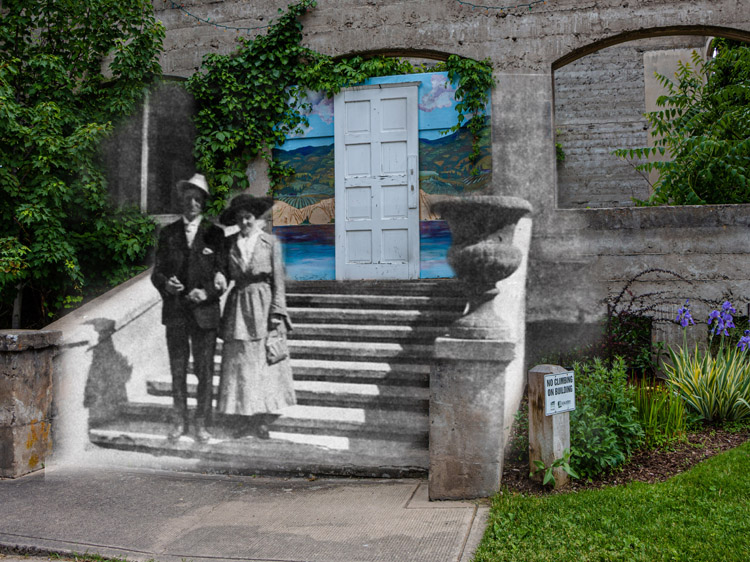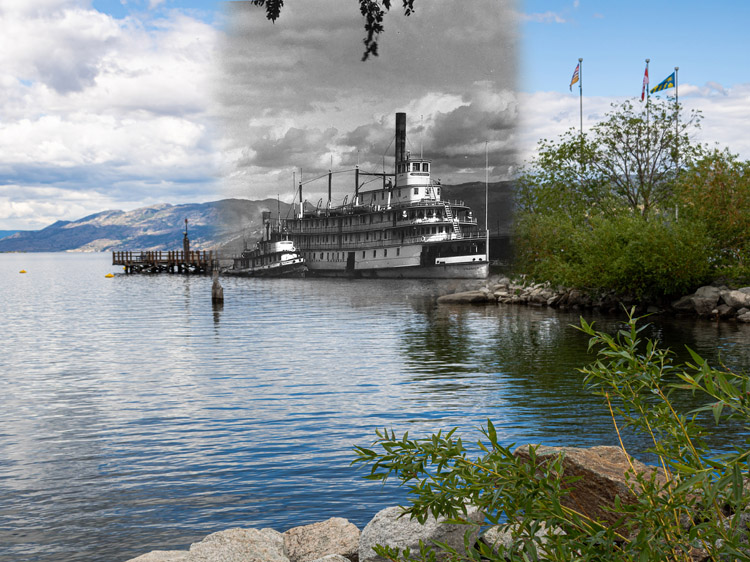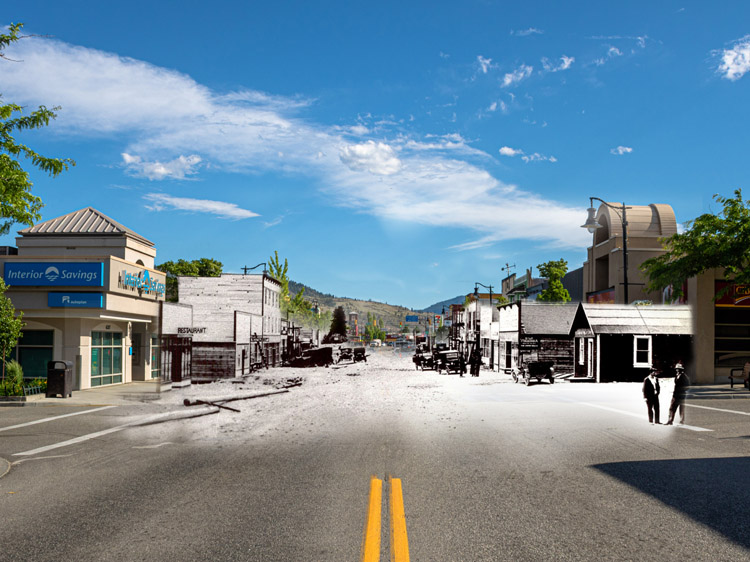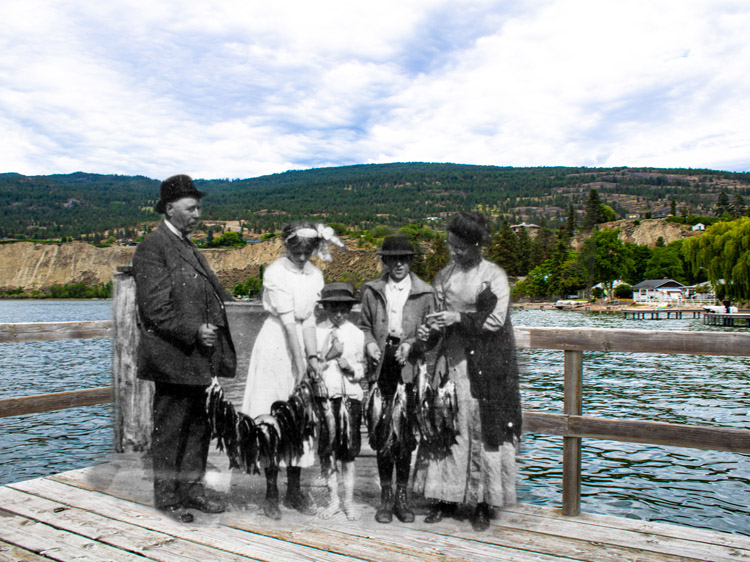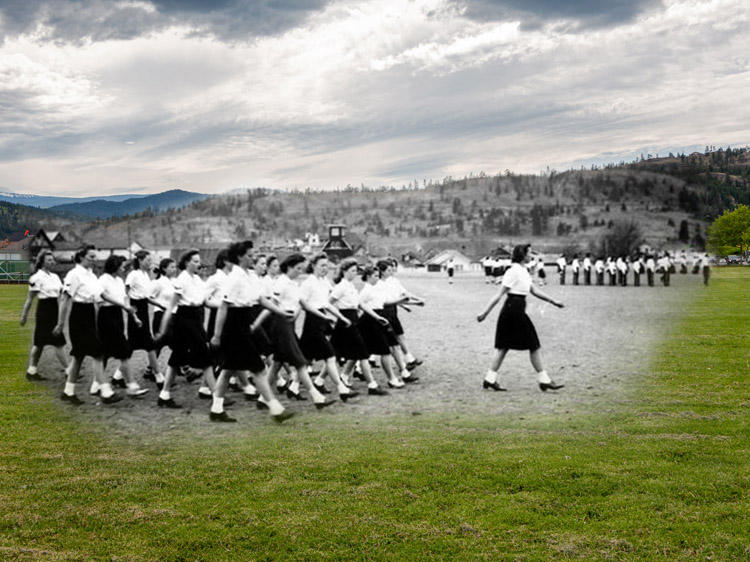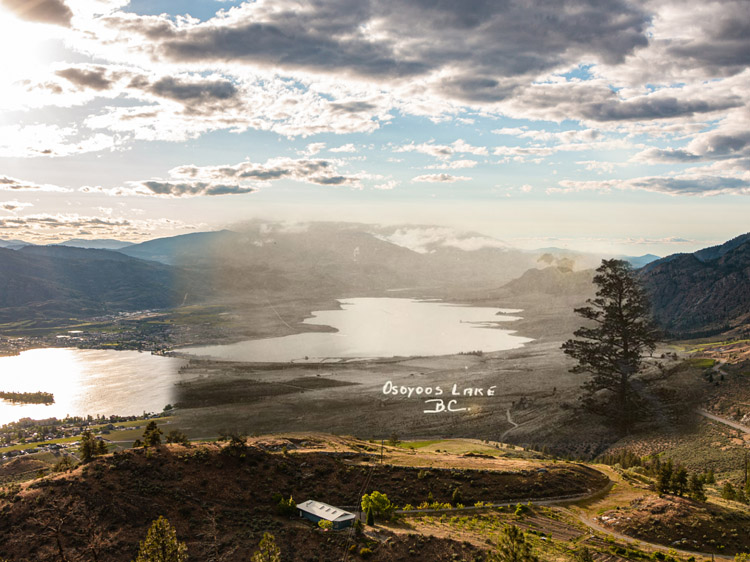For thousands of years, the falls at the southern end of Skaha Lake were an important gathering place for the Syilx People of the Okanagan Nation. Each year, the community would gather at the base of the falls to celebrate and prepare for the annual salmon run and to elect the Salmon Chief. When Europeans began to settle in the Okanagan Valley, the town of Okanagan Falls, originally known as "Dog Town", grew at the base of the falls. Its key founder, W.J. Snodgrass, arrived in the area in 1892 with big dreams for a bustling city here, complete with a university. However, the difficulty of travelling from Okanagan Falls to the bigger settlements already being established farther north quashed Snodgrass's ambitions, and the town of Okanagan Falls became a small but thriving community. Frequent flooding each year led to the construction of flood control dams on the Okanagan River, submerging the town's namesake falls. Today, the community is a small, tight-knit town on the edge of Skaha Lake.
This project was made possible through a partnership with Visit South Okanagan, with support from the Regional District of the Okanagan-Similkameen Area "D" and the Okanagan Falls Heritage Museum and Bassett House.
We respectfully acknowledge that Okanagan Falls is within the ancestral, traditional, and unceded territory of the Syilx People of the Okanagan Nation.
Explore
Okanagan Falls
Stories
The Missing Falls of Okanagan Falls
Story Location
Okanagan Falls was originally named "Dog Town", a name which came from the settlers' misunderstanding of the meaning of the Okanagan Nation word "Skaha", which is the name of the nearby lake and means "horse" rather than "dog". However, settlers to the region quickly renamed the community "Okanagan Falls" after the two small waterfalls which cascaded along the Okanagan River next to the townsite and once ran by right in front of you.
* * *
These waterfalls were a place of great importance to the Okanagan First Nations people for centuries before white settlers had ever set eyes on them. For millennia, the Syilx Okanagan people thrived in the Okanagan Valley, living sustainably off the land and developing trade routes across their territory and beyond. They sustained themselves by fishing, hunting, and growing crops. Their traditional territory stretches from Mica Creek in the British Columbian interior down to Wilbur in Washington State and from Guichon Creek to Kootenay Lake in the east.1
The falls that give the modern town its name were an important annual gathering and trading place for the Syilx Okanagan people. It was here they prepared for the winter salmon harvest on the Okanagan River and elected the Salmon Chief, who was responsible for ensuring all members of the community received enough salmon to last the winter.
When Europeans began settling in the area in the nineteenth century, they disrupted the Syilx people's ways of life, bringing disease and evicting them from their territories. The newly-defined international border cut the Okanagan nation in half, and no land treaties were ever drawn up in the area.
The same natural abundance concentrated around the falls also attracted Europeans to the area, and they built a town here. The settlers quickly discovered, however, that their manner of living in permanent settlements was not as well suited for the spot, and the town suffered frequent devastating floods whenever water levels were high on both the Okanagan River and Skaha Lake.
In 1942, the BC and federal governments formed a joint Board of Engineers to look into methods of flood control in the valley. They concluded that the natural river system simply could not handle peak spring water flows, which was making flooding an almost annual occurrence. In response, a flood control dam was constructed on the Okanagan River in the 1950s.2 In the process, however, the double falls were destroyed.
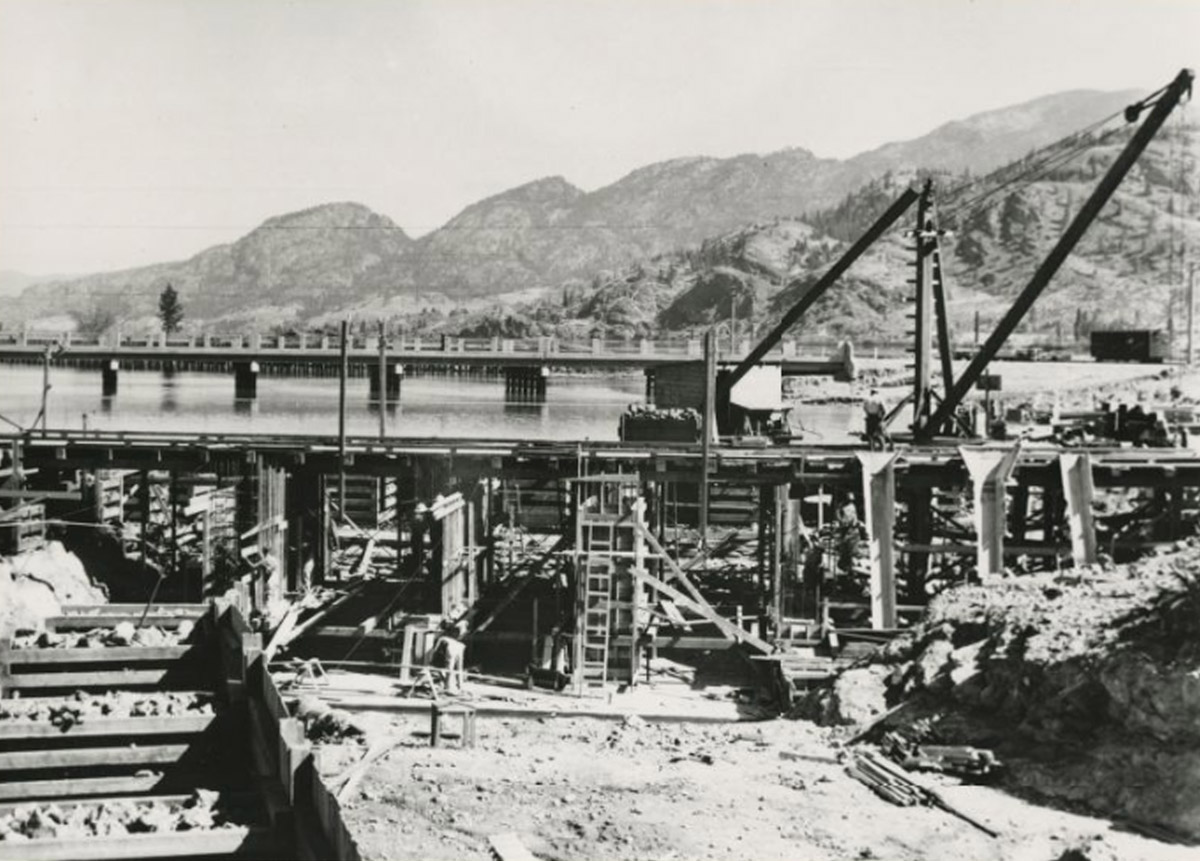
Today, the town of Okanagan Falls is continuing to work towards building closer ties with the local Osoyoos Indian Band. A statue honouring the Salmon Chief was unveiled in Christie Park in 2011 by Osoyoos Indian Band Chief Clarence Louie and the area director at the time, Bill Schwarz. It was sculpted by Smoker Marchand of the Colville Okanagan Nation Band, in the US.3
The Osoyoos Indian Band is today a thriving and successful community, and Chief Louie was awarded an Order of Canada in 2016 to recognize his role in bringing prosperity to the Band. Elected Chief in 1985 at the age of 24, he has since helped establish profitable business developments and important cultural ventures to revitalize his community.
2. Webber, Jean. A Rich and Fruitful Land: The History of the Valleys of the Okanagan, Similkameen and Shuswap. Harbour Publishing, Madeira Park, 1999, pp 19.
3. "History and Culture." Area "D": Okanagan Falls and Surrounding Areas. URL: https://okfalls.ca/play/history-and-culture/
The Dream of Dog Town
Okanagan Falls Heritage Museum & Bassett House
Story Location
The original white settlers of Okanagan Falls—formerly called Dog Town—had big dreams for this community, envisioning it becoming a major economic centre and transportation hub within the Okanagan. One of the town's founders, W.J. Snodgrass, who came to the Okanagan from Portland, Oregon, in 1892 drew up a townsite plan which included not just schools, parks and hotels, but a city hall and a university—ambitious undertakings for a town that still largely existed only on paper.1
* * *
In the history of most Canadian communities, growth is directly linked to transportation, and in early Okanagan Falls, the scene seemed set for this kind of growth. Its location at the southern end of Skaha Lake, along with the presence of the Okanagan River between the Skaha and Okanagan lakes, created the promise of a connection to the northern region of the Okanagan and beyond.
When Snodgrass arrived, he poured his energy into establishing the community. He oversaw the building of a hotel, a store, and a sawmill and founded a stage and freight coach service to ship goods between Grand Forks and Penticton. He also launched one of the first steamboats on Skaha Lake, the SS Jessie, named for his second daughter. Unfortunately, the Jessie only ran for four years, between 1894 and 1898, before burning at the dock in Okanagan Falls. Undaunted, Snodgrass went on to run two more steamships, the SS Greenwood and the SS Maud Moore.
Yet there was a key flaw in Snodgrass's expansive vision: the Okanagan River between Skaha Lake and Okanagan Lake was narrow and treacherous, difficult for boats to navigate. While the Jessie is said to have been the first steamship to navigate this tricky portion of water, she was among few vessels to manage it. The SS Fairview, for instance, was originally built in the 1890s to travel between Penticton and Dog Town (now Okanagan Falls) but proved to be too big to make it through the river. Likewise, the SS Kaleden(2) was built in 1910 for this purpose but was too long to make the river's hairpin turns. It made one treacherous trip between the lakes before being reassigned to Okanagan Lake instead.2
As one historian concluded: "The inability of the early freight boats to navigate the winding channel of the Okanagan River between Okanagan and Skaha Lakes probably led to the demise of Okanagan Falls as a large center."3
Snodgrass's steamship the Maud Moore was sold to JM Robinson and moved to the Okanagan Lake in 1905 to serve as a ferry between Summerland and Naramata. From 1905 to 1922, there were no steamships on Skaha Lake. The town of Okanagan Falls developed into a community, yet it remained a small one, close-knit and remote. Snodgrass's dreams of a big city in the valley slowly vanished from view, and he left Okanagan Falls to return to Oregon in 1908.
Then, in 1922, the Canadian Pacific Railway entered the scene, momentarily rejuvenating the transportation links on Skaha Lake. The railway company had completed the Kettle Valley Railway in 1915, connecting Penticton to the rest of the world by rail. Seven years later, the company built a spur line to Skaha Lake and ran the steamer the SS York across the water to the town. In 1930, this boat was replaced with a railway line which ran along the west side of Skaha Lake to Okanagan Falls.
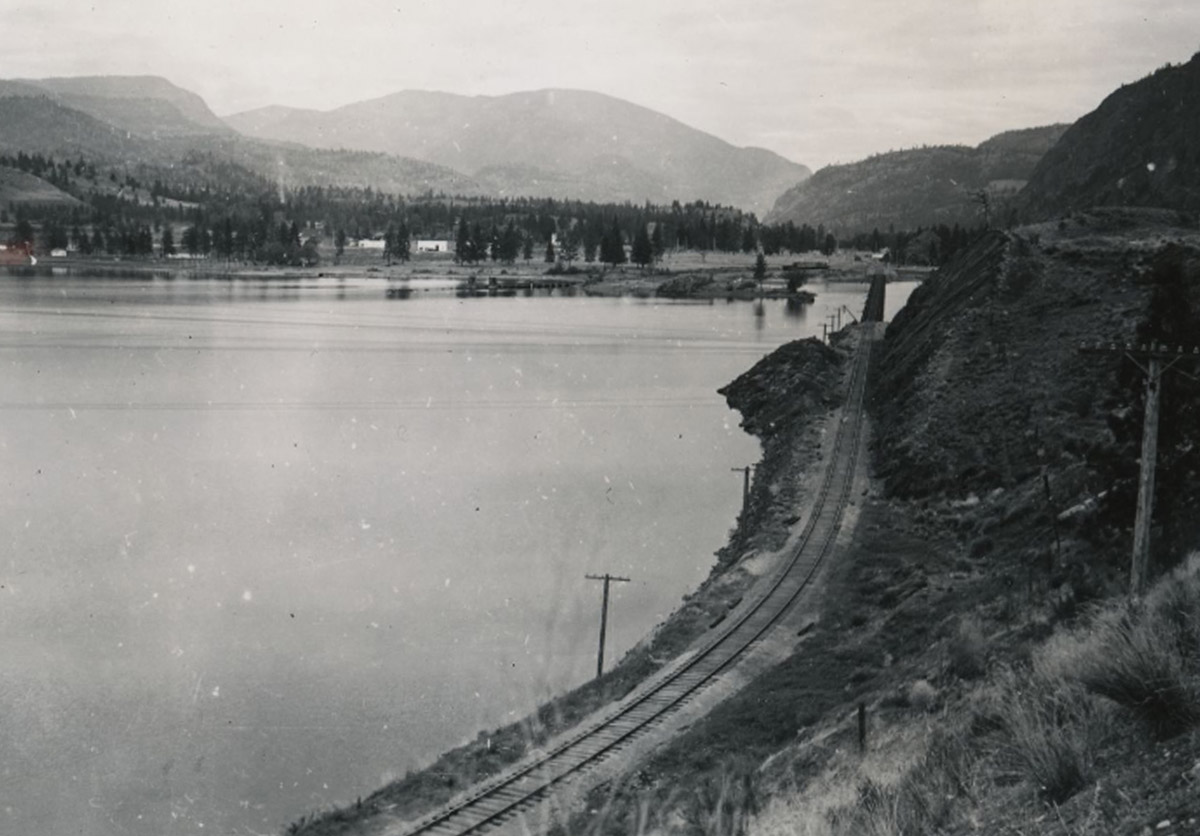
Today, both steamships and railway are gone, and Highway 97 makes these transportation challenges all but obsolete. However, the KVR's route remains nearly intact and is today a world-renowned biking and hiking path.
2. Webber, Jean. A Rich and Fruitful Land: The History of the Valleys of the Okanagan, Similkameen and Shuswap. Harbour Publishing, Madeira Park, 1999, pp. 147-148.
3. Cox, Doug. Okanagan Roots… A Historic Look at the South Okanagan and Similkameen. Skookum Publications, 1987, pp. 66
A Rodeo Legend
Okanagan Falls Heritage Museum & Bassett House
Story Location
Cattle ranching has been a part of the South Okanagan ever since the first white settlers arrived in the region. Many of the first landowners were wealthy ranchers with thousands of head of cattle and acres and acres of ranching land. The culture of cattle ranching and rodeos runs deep in the South Okanagan, and nowhere is this more true than in Okanagan Falls.
* * *
In the late nineteenth and early twentieth centuries, ranchers in the South Okanagan mostly sold their cattle to railway workers and farming and mining communities in the Okanagan, Boundary Country, and even as far away as the Kootenays. Transporting their livestock meant long, difficult cattle drives. In 1915, this got easier with the opening of the Kettle Valley Railway in Penticton, and in 1943, the journey was again shortened when the cattle stockyards opened in Okanagan Falls.
Pioneer Morris Thomas, who was born in Okanagan Falls in 1930, was instrumental in the creation of the yards and served as the elected president of the BC Livestock Producers Cooperation for over 20 years, from 1968 to 1989. As well as being a key part of the livestock organization, Morris helped with the construction of the stockyards themselves—some of the posts he planted are still there, nearly eighty years later.
The founding of the stockyards provided an economic boost to the community. Originally run by the Southern Interior Stockman's Association, which was formed in 1943, the yards drew crowds of people to Okanagan Falls whenever there was a sale. The small community, unused to large groups of visitors, had no hotel at the time; visiting cattlemen simply pitched their tents in the nearby fields or slept beneath the stars. The local Women's Institute cooked the men their meals and served them in the Community Hall, and the entire event became a festival and celebration, with a dance held annually before the day of the sale.1
As one local historian remarked in the 1960s, the stockyards put Okanagan Falls on the map: "This pavilion is bringing recognition to Okanagan Falls from well beyond the boundaries of the province."2
Yet the stockyards aren't Okanagan Falls only claim to cattle fame. Rodeos have been a big part of the community for over a century. They were taking place in Okanagan Falls as early as the 1920s, on a property near the Alexandra Hotel. Before that, they took place at White Lake to the southwest of the town, where the Dominion Radio Astrophysical Observatory now sits. The chutes and corrals constructed in and near the town made Okanagan Falls "the place to be" for rodeo culture in the Okanagan.3
More recently, Okanagan Falls was the home of a rodeo legend: Kenny McLean. McLean was born in 1939 and grew up on his father's ranch in Okanagan Falls as the youngest of ten children. He would go on to become the only rodeo cowboy in the BC Sports Hall of Fame.
His induction into the Hall of Fame was for good reason: over the course of his career, he won an unprecedented three US National Saddle Bronc titles and five Canadian Pro Rodeo Association Saddle Bronc Championships, was awarded the Linderman Award for excellence in the sport twice, and was given an Order of Canada in 1976. His skills were legendary. At the National Finals Rodeos in the US, he was bucked off only five times—out of 77 rides. In a Vancouver Sun article celebrating noteworthy British Columbians, he was described as "One of the greatest athletes most Canadians have never heard of."
McLean first learned to ride at two years old, and he never stopped. He participated in his first rodeo in 1956 at the age of 17, won the title of "Rookie of the Year" in 1961, and continued to participate in rodeos until his death in the saddle in 2002, when he suffered a heart attack during a seniors' roping event in Taber, Alberta. Today, Okanagan Falls and the rodeo world still remember him as a legend among the world of cowboys. A bronze statue in the town's Centennial Park honours him.
2. Badgley, Edna. "Chronicle of a Community -- a History of Okanagan Falls." Keremeos Review, September 2012.
3. 1. Cox, Doug. 35.
4. Hume, Stephen. "Canada 150: Kenny McLean's rodeo standards have never been equalled." Vancouver Sun, January 2017. URL: https://vancouversun.com/news/local-news/canada-150-kenny-mcleans-rodeo-standards-have-never-been-equalled
Then and Now Photos
A View of the Okanagan River
Okanagan Falls Heritage Museum & Bassett House
1900
This view over the Okanagan River and Skaha Lake shows the old log bridge which used to span the river and the rapids that were later submerged by the construction of the flood control dam.
Dominion Day at the Wharf
Okanagan Archival Trust Society OKF 004
1902
The crowds in this photograph have gathered on the wharf to celebrate Dominion Day (Canada Day) with a trip out on Skaha Lake.
The Okanagan Falls Wharf
Okanagan Archival Trust Society OKF 001
1914
In this photograph of the Okanagan Falls wharf in 1914, the gasoline-fuelled passenger boat The Mallard is pulled up at the dock and a car is meeting it. The Mallard ran between Penticton, Kaleden and Okanagan Falls beginning in 1914 and was one of the only passenger boats to successfully navigate the Okanagan River between Okanagan Lake and Skaha Lake. Unfortunately, she eventually sunk while going over a control dam with a ton of apricots on board for cargo.
The Bassett Family
Okanagan Archival Trust Society OKF 015
1922
This photograph from 1922 shows Dick and Maggie Bassett with their three daughters outside of their house. The family operated a stagecoach and freighting company in Okanagan Falls during the town's early years. The house is now home to the Okanagan Falls Heritage Museum.
A Truck By the Falls
Okanagan Archival Trust Society OKF 103
1927
In this photo from 1927, two men pose with their truck in front of the falls which gave Okanagan Falls its name. In the background, a wooden bridge spans the river.
The Blasted Church
Okanagan Falls Heritage Museum & Bassett House
1930
The United Church in Okanagan Falls, often known as the "Blasted Church", was first built in Fairview, a mining town near Oliver which experienced a rapid cycle of boom and bust, becoming a ghost town by 1920. When the Okanagan Falls congregation decided to move the abandoned church to their home, they realized that pulling out the building's nails would splinter the wood. Instead, they blasted the building apart with dynamite, carried the pieces to Okanagan Falls, and reassembled it there.
A View Over the Townsite
Okanagan Falls Heritage Museum & Bassett House
1940
This photograph shows a view over the townsite of Okanagan Falls and the shores of Skaha Lake. The highway and railway bridge are clearly visible across the water, while in the foreground, farms are planted right down to the town. Many of the streets which currently exist have not yet been built.
Main Street
Okanagan Archival Trust Society OKF 005
1950
This photo looks along the highway towards Main Street. The OK Barbeque, Lakeview Chevron, Lakeview Motel and the Community Hall are all visible on the right side of the road.
Cars Parked at the OK Falls Hotel
Okanagan Falls Heritage Museum & Bassett House
1950
This photograph from 1950 shows the OK Falls Hotel, which opened along the highway that same year.
The OK Falls Hotel
Okanagan Archival Trust Society OKF 048a
1950
The OK Falls Hotel was built in 1950, the same year in which this photograph was taken of it. The hotel remained open as a bustling part of the community until 2018, when it was temporarily closed.
Skaha Lake
Okanagan Archival Trust Society OKF 097
1955
This postcard shows Skaha Lake and the beach at Okanagan Falls. Today, Christie Park is located in this spot, and the beach is a popular place to spend time in the warmer weather.
Building the Dam
Okanagan Falls Heritage Museum & Bassett House
1958
Because of frequent flooding, a control dam was built on the Okanagan River in the 1950s to regulate water levels. Unfortunately, the construction project, seen here in a photograph from 1958, destroyed the town's namesake falls.

